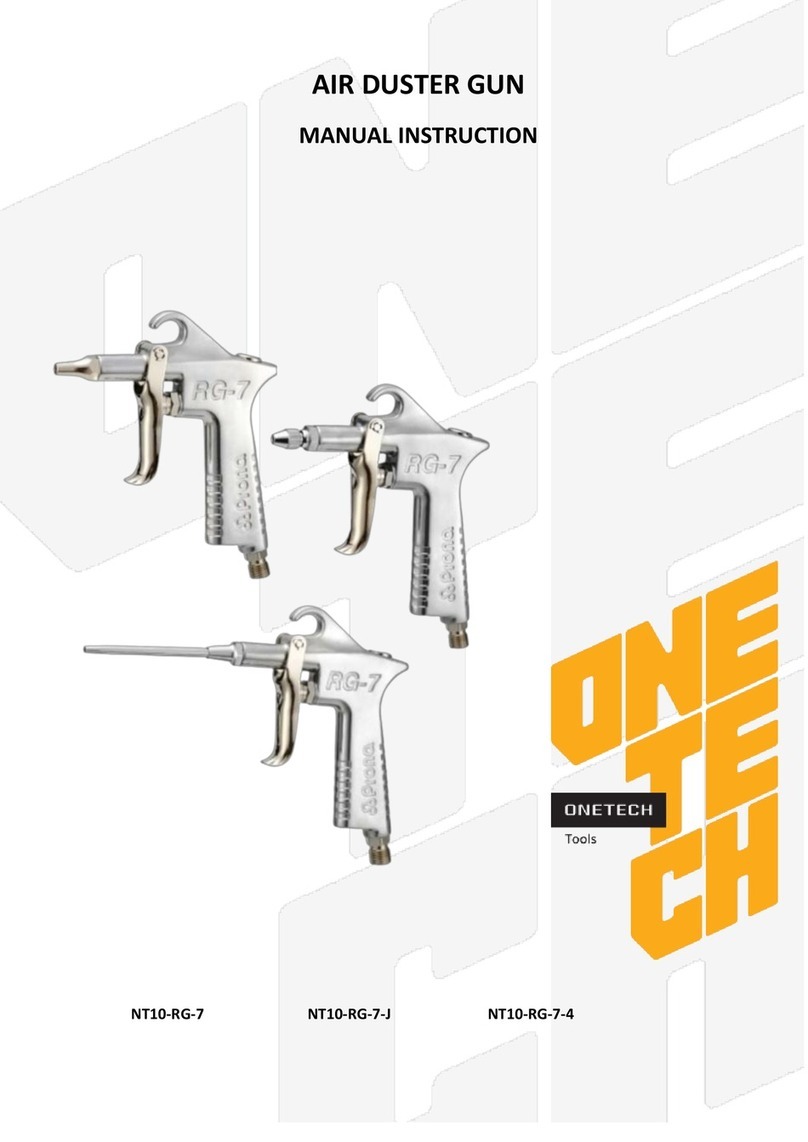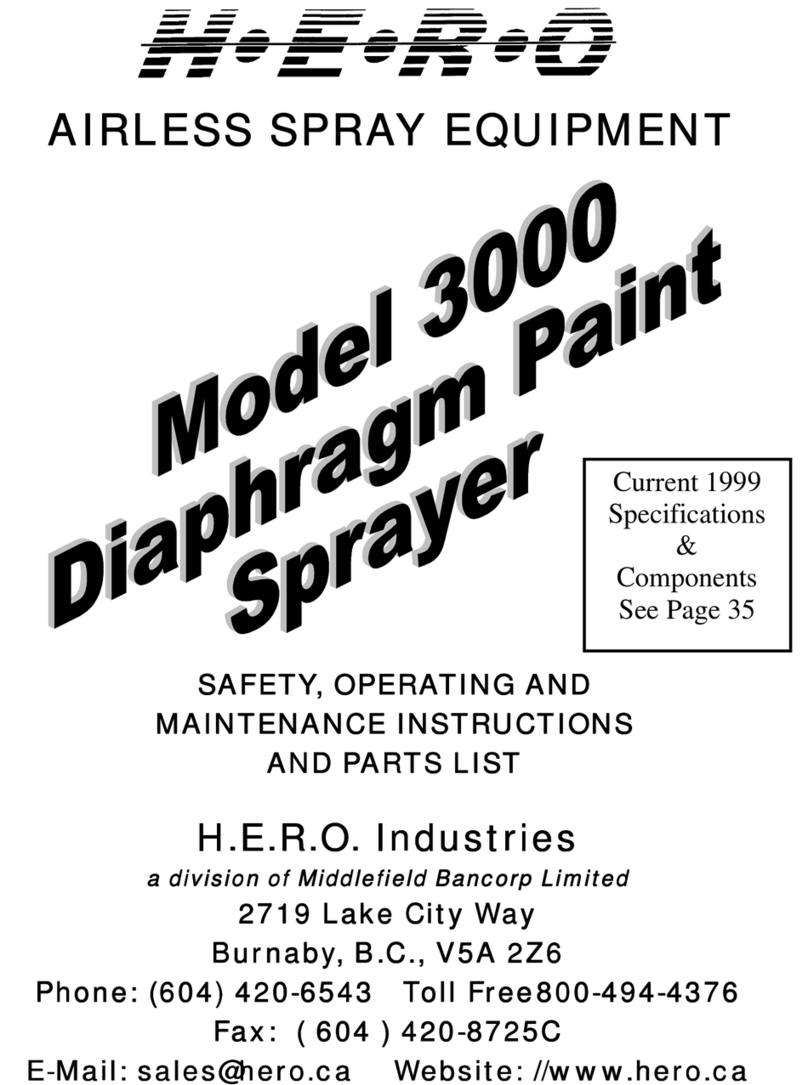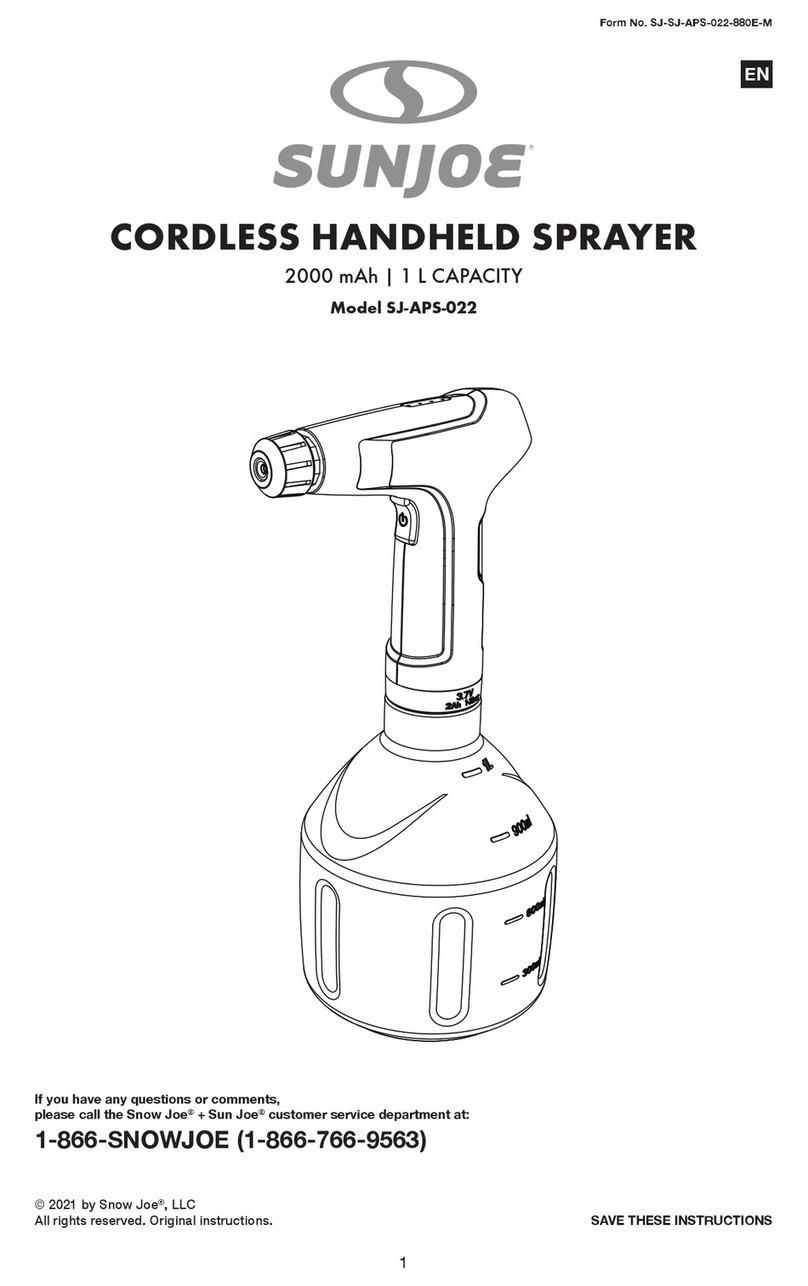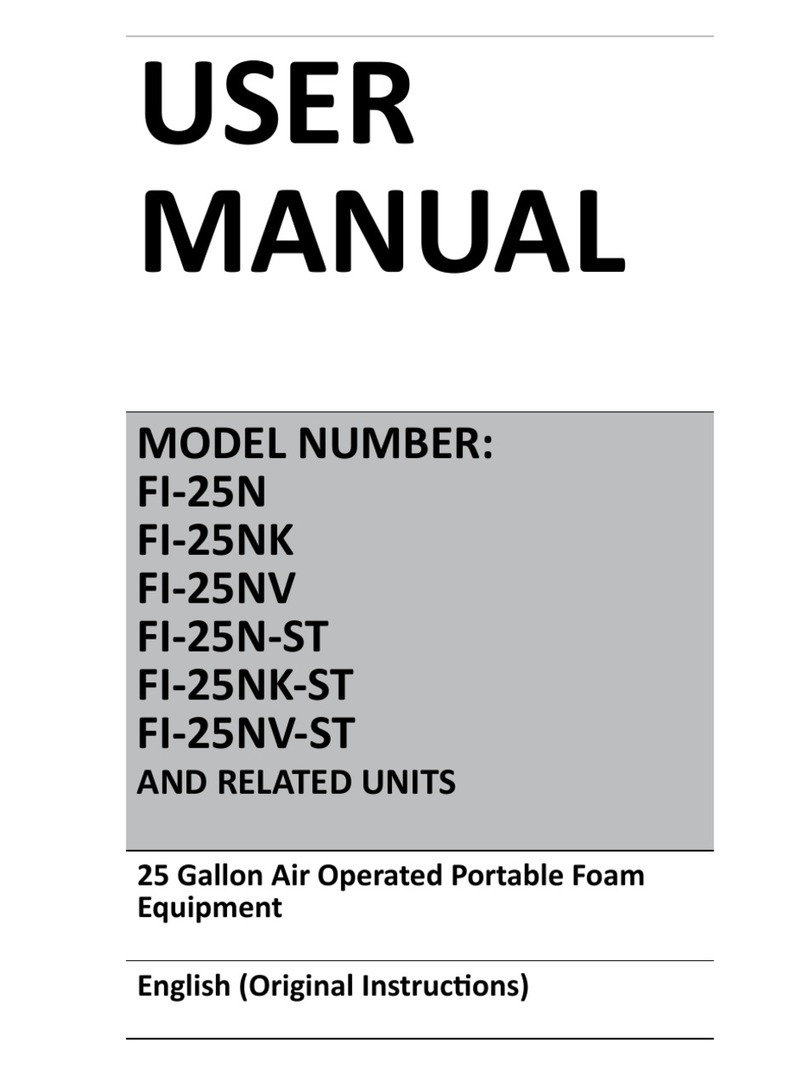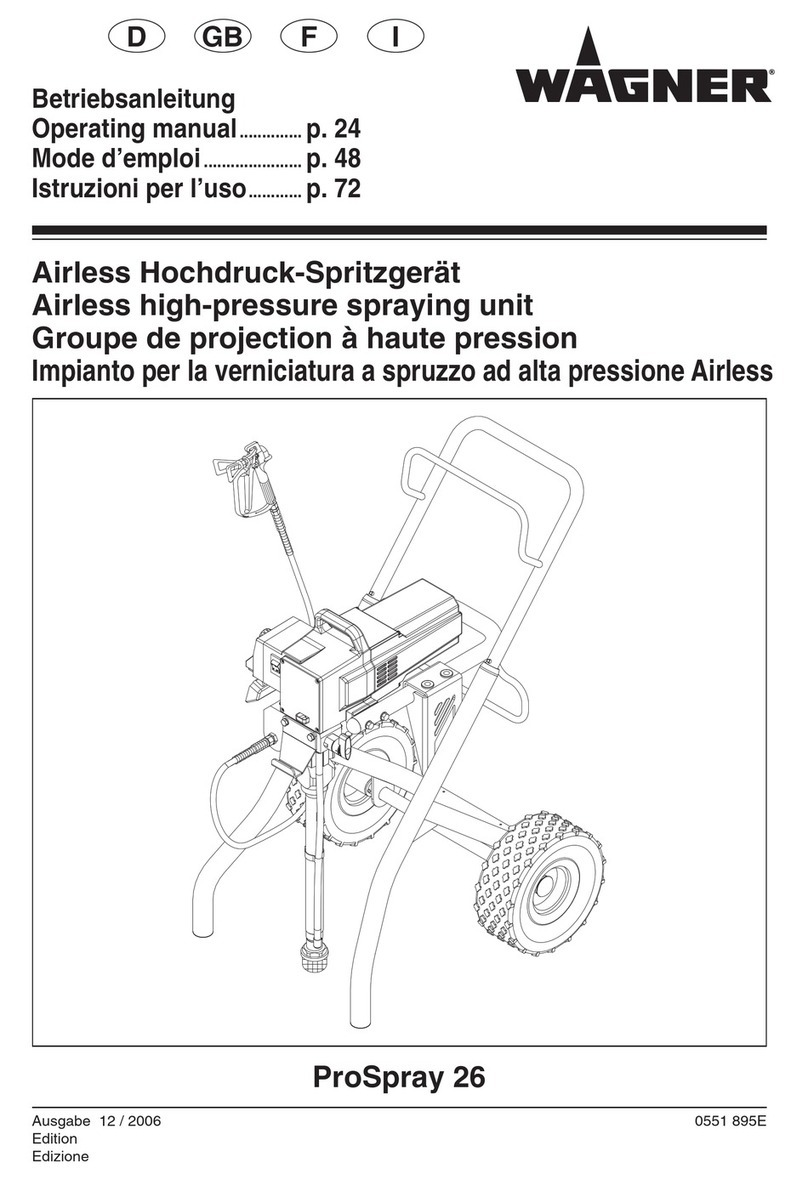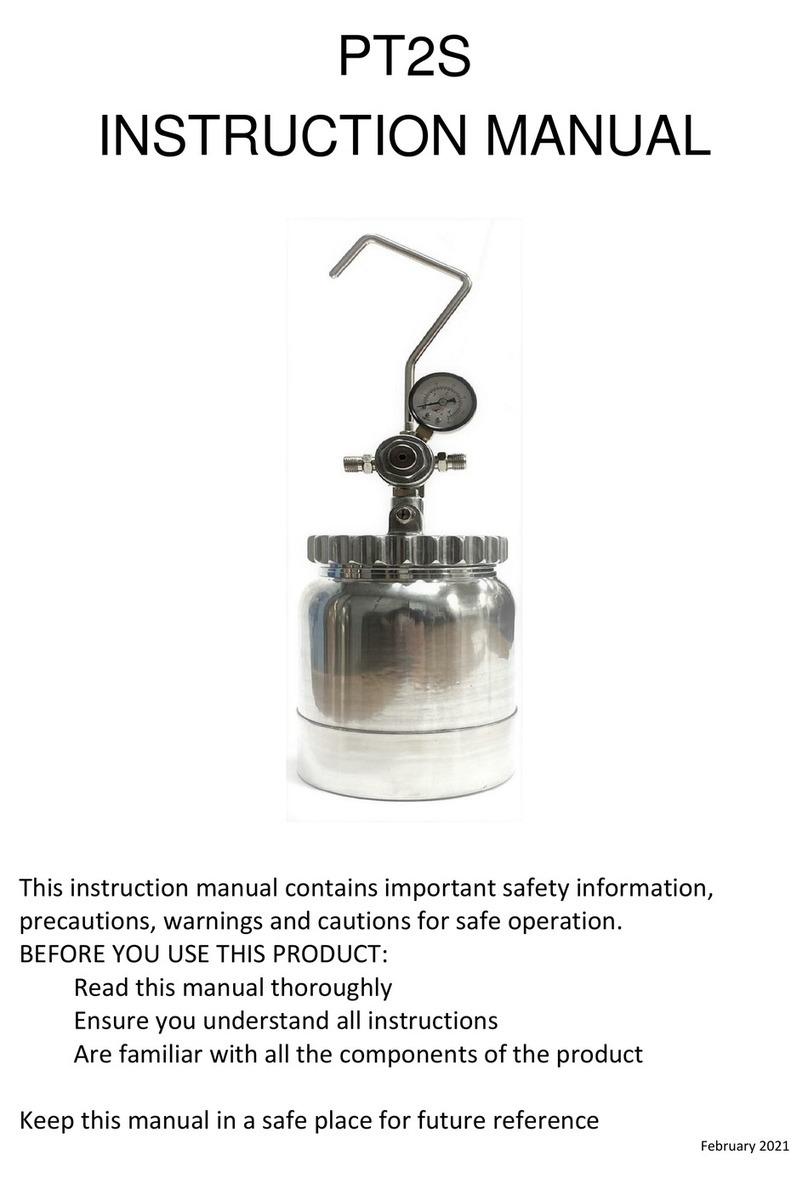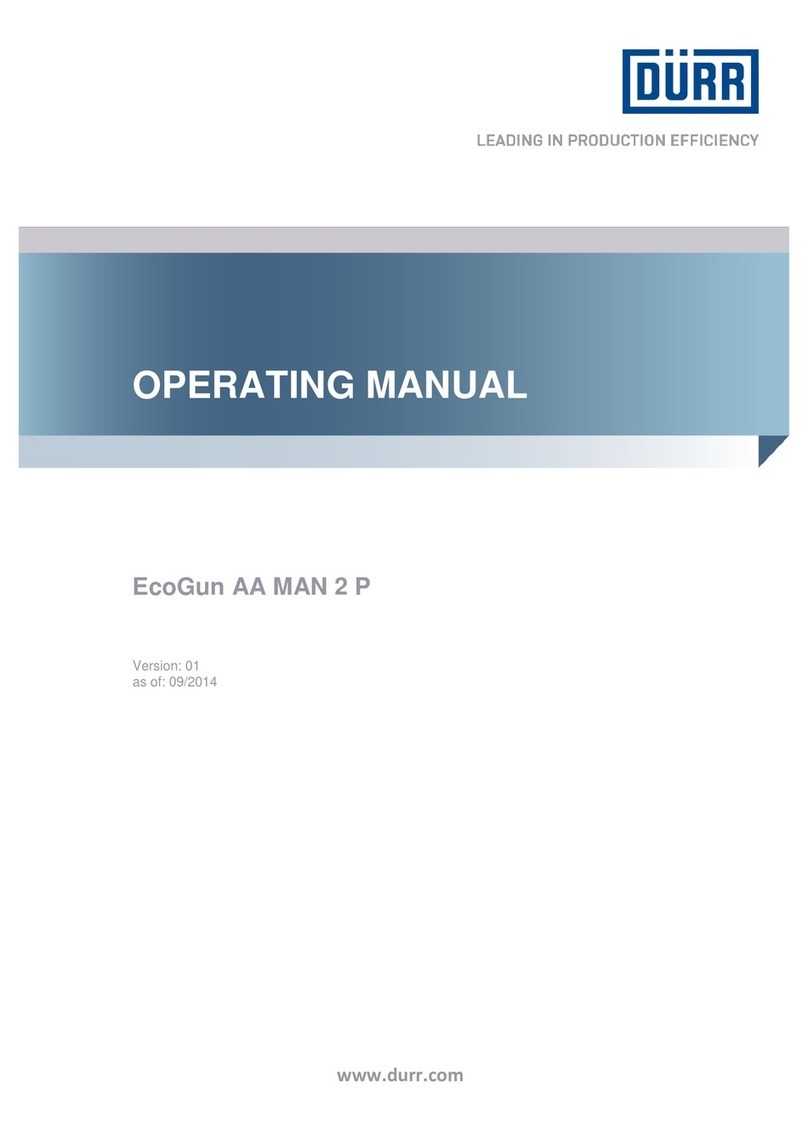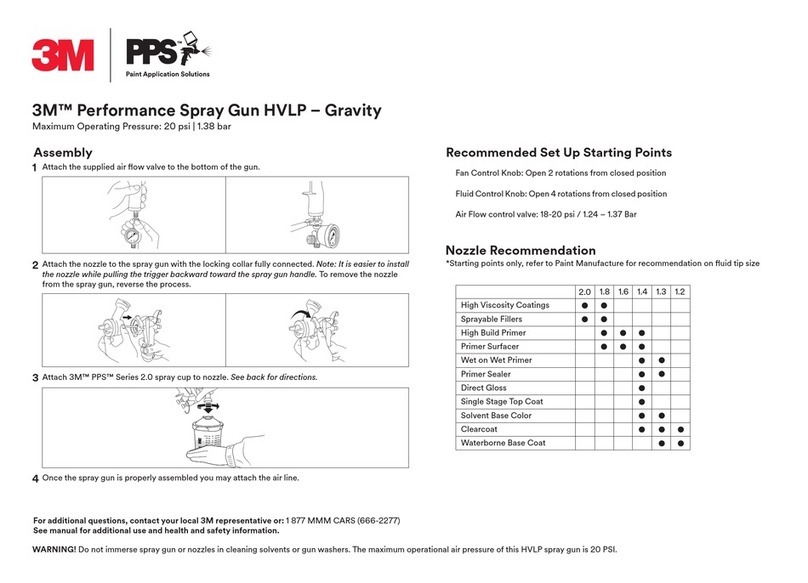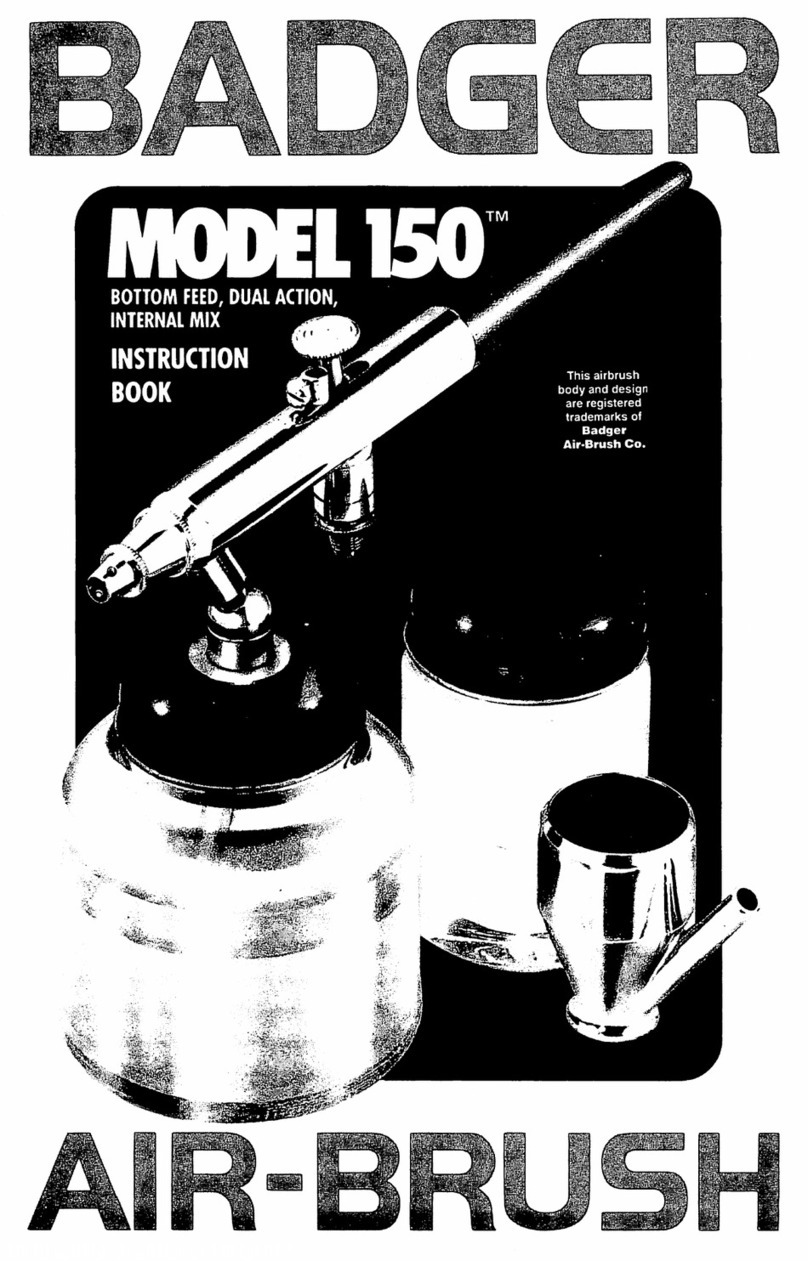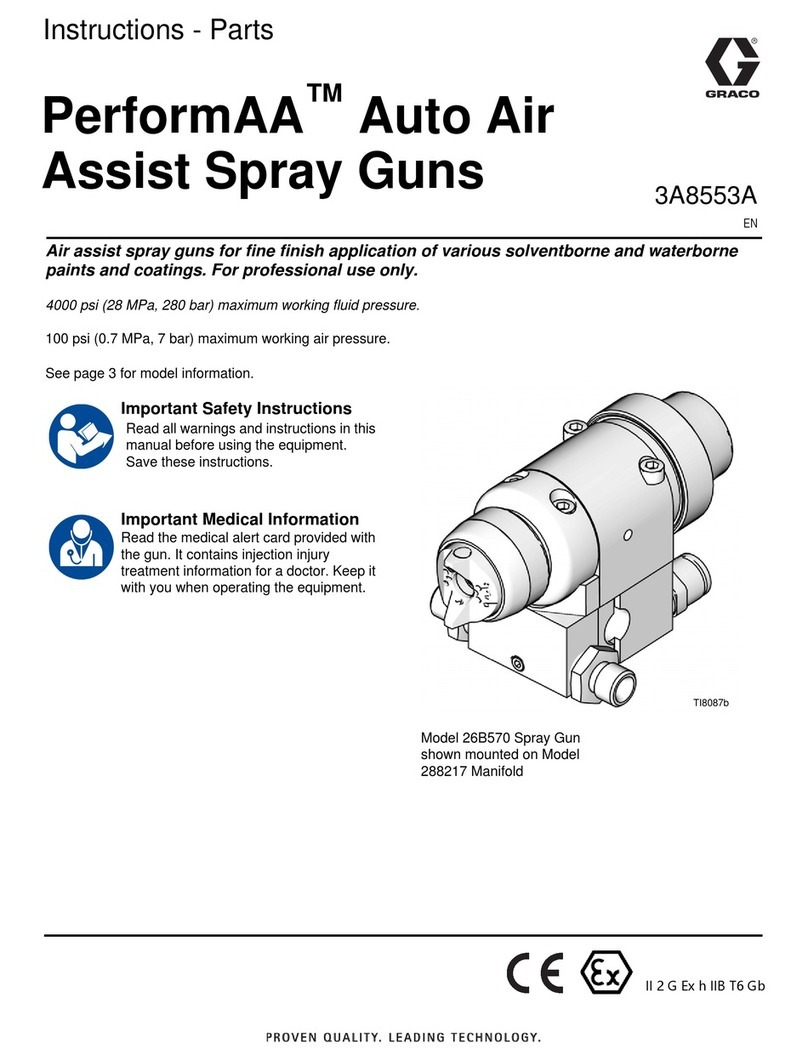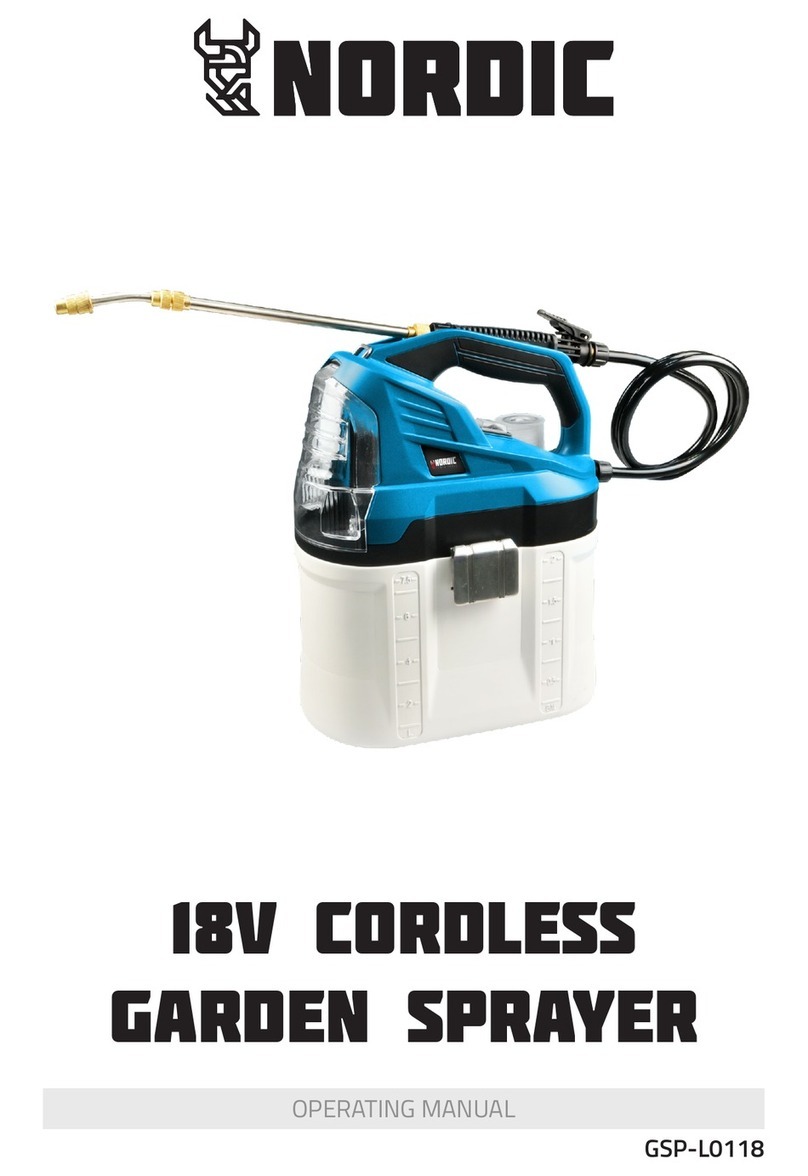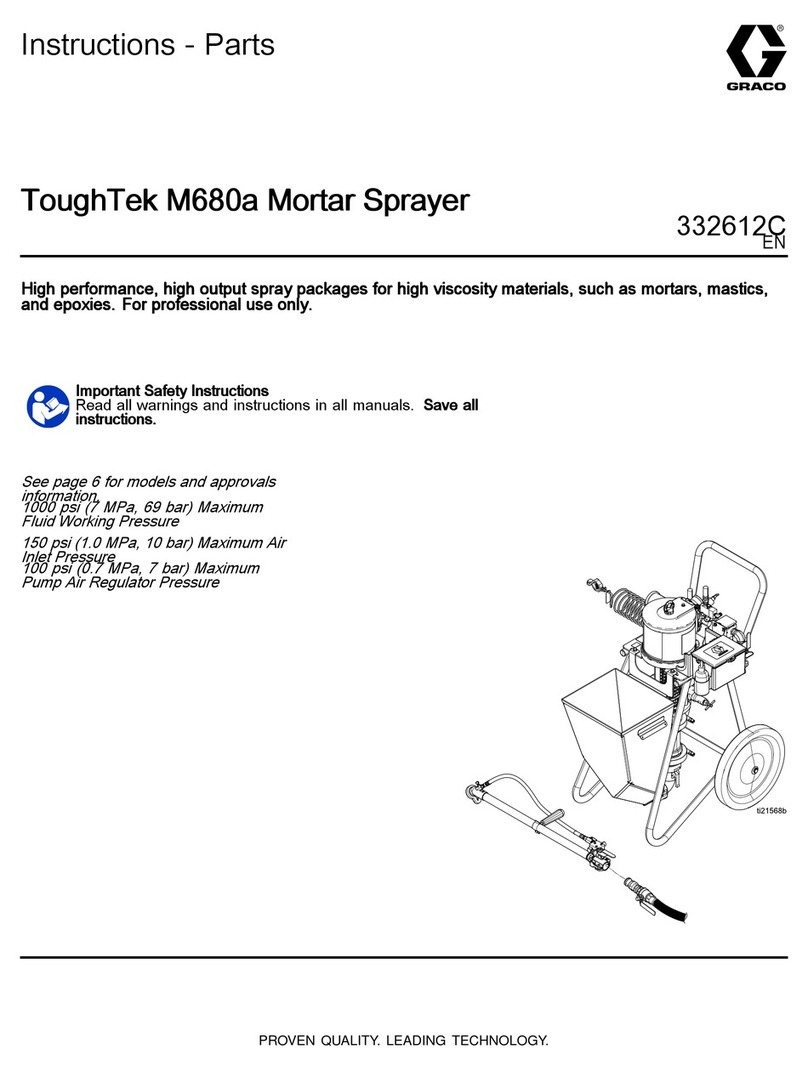Sherwin-Williams PT2500 User manual

OWNER’S MANUAL
820–133
Rev
D
Supersedes
C AND PCN D
1/4 GALLON PER MINUTE, 120 V
AC, 60 HZ
SHERWIN–WILLIAMS
PT2500
Electric
Airless Paint Sprayer
3000 psi (210 bar) Maximum Working Pressure
Model 820–113, Series C
Complete
Sprayer with hose and gun.
U.S.
Patent No. 4,616,982
U.K. Patent No. 2,165,591
Other Foreign Patents Pending
The
SHER
WIN-WILLIAMS COMPANY, CLEVELAND, OHIO 44115
COPYRIGHT 1991, GRACO INC.
This
manual contains important
warnings and information.
READ AND RETAIN FOR REFERENCE

Before you use the SHER
WIN WILLIAMS PT2500
Sprayer, please read this en
-
tire instruction manual. The manual contains important information that will help
you operate the sprayer safely and ef
ficiently
, and will help you keep the sprayer in
top operating condition.
Table
of Contents
Terms 2.
. . . . . . . . . . . . . . . . . . . . . . . . . . . . . . . . . . . . . . . .
PT2500
Sprayer Description
3.
. . . . . . . . . . . . . . . . . . . .
Warnings 4
. . . . . . . . . . . . . . . . . . . . . . . . . . . . . . . . . . . . . .
Avertissement
(French W
arnings) 6.
. . . . . . . . . . . . . . .
Advertencia
(Spanish W
arnings) 8.
. . . . . . . . . . . . . . . .
Setup 10
. . . . . . . . . . . . . . . . . . . . . . . . . . . . . . . . . . . . . . . .
Startup 11
. . . . . . . . . . . . . . . . . . . . . . . . . . . . . . . . . . . . . . .
Maintenance 13
. . . . . . . . . . . . . . . . . . . . . . . . . . . . . . . . . .
Application
Methods
15.
. . . . . . . . . . . . . . . . . . . . . . . . . .
Troubleshooting 16
. . . . . . . . . . . . . . . . . . . . . . . . . . . . . . .
Repair
Instructions
18.
. . . . . . . . . . . . . . . . . . . . . . . . . . .
Parts
Drawings and Lists
20.
. . . . . . . . . . . . . . . . . . . . . .
Graco
Phone Numbers
Back Cover
.
. . . . . . . . . . . . . . . .
Technical
Data
Back Cover
.
. . . . . . . . . . . . . . . . . . . . . . .
Warranty Back
Cover
.
. . . . . . . . . . . . . . . . . . . . . . . . . . . .
Terms
Be
sure you read and understand each of these terms
before reading the rest of the manual.
WARNING
Alerts the user to avoid or correct condi
-
tions which could cause injury
.
CAUTION
Alerts user to avoid or correct conditions
which could damage or destroy the equipment.
PRESSURE RELIEF PROCEDURE
A safety proce
-
dure for relieving fluid pressure in the system.
FLUID INJECTION INJUR
Y
A injury
, which may ap
-
pear to be only a simple cut, caused by the high pres
-
sure injection of fluid directly into the body
.
NOTE
Gives additional explanation of a procedure or
helpful hints.
CAUTION
A torque wrench is needed to properly check and
tighten
the valves and screws on this sprayer
. Failure
to torque these parts at the specified intervals (see
page 13) will result in leaking and damage to the
sprayer.
Liquids can be injected into the body by high pressure airless
spray
or leaks – especially hose leaks.
Keep
body clear of the nozzle. Never stop leaks with any part of the
body.
Drain
all pressure before removing parts. A
void accidental
triggering
of gun by always setting safety latch
when not spraying.
Never
spray without a tip guard.
In case of accidental skin injection, seek immediate “Surgical
Treatment”.
Failure
to follow this warning can result in amputation or serious
injury.
FIRE
AND
EXPLOSION HAZARD
SKIN INJECTION
HAZARD
READ AND UNDERSTAND ALL LABELS AND INSTRUCTION MANUALS BEFORE USE
Spray
painting, flushing or cleaning equipment with flammable liq
-
uids
in confined areas can result in fire or explosion.
Use
outdoors or
in extremely well ventilated areas. Ground equip
-
ment,
hoses, containers and objects being sprayed.
Avoid all ignition sources such as static electricity from plastic
drop
cloths, open flames such as pilot lights, hot objects such as
cigarettes,
arcs from connecting or disconnecting
power cords or
turning
light switches on and off.
Failure
to follow this warning can result in death or serious injury
.
French 185–956
Spanish 185–961
German 186–041
Greek 186–045
Korean 186–049
English 185–953
Danger Labels
The
DANGER label shown on below is also on your sprayer
. If
you have painters who do not read that language, order one of
the following labels to apply to your sprayer
. Apply the label at A
for the best visiblity
. Order the labels directly from your Graco
distributor without charge.
A

KEY
A Hydraulic
pump
B
Rac IV DripLess tip guard
and spray tip
4
Pressure control knob
5
Hydraulic oil fill cap
11
ON/OFF switch
18 Motor
21 Diaphragm
22
Paint pump
27 Strainer
59
Drain tube
66
Bypass valve
67 Outlet
101
Paint hose
102
Spray Gun
59
0266
0267
0270
27
66
4
63
A
5
102
101
B
18
11
21
22
1
3
4
2
Decrease
pressure (counterclockwise).
Increase
pressure (clockwise).
Open (counterclockwise).
Close (clockwise).
1
2
3
4
1
3
4
2
Decrease
pressure (counterclockwise).
Increase
pressure (clockwise).
Open (counterclockwise).
Close (clockwise).
Motor
The
SHER
WIN-WILLIAMS PT2500 Sprayer has a 1/2
HP
, 120 V
, 60Hz AC, single phase, 1725 rpm motor
(18). The motor is supplied with a three-wire power
supply cord and a three-prong plug. The sprayer ON/
OFF switch is located on the box on the side of the
motor. The motor’
s function is to drive the hydraulic
pump. The motor runs continuously when it is turned
on to keep the paint at the desired pressure.
Paint Pump
The paint pump (22) is immersed directly into a 5 gal
-
lon paint pail, so the pump is actually being pressure
fed without the mess and trouble of pouring paint into a
hopper.
Hydraulic Pump
The hydraulic pump (A) is located inside the hydraulic
reservoir
. The motor drives an eccentric bearing which
pushes the piston in and out of the hydraulic pump.
The pump reciprocates the hydraulic fluid to operate
the diaphragm.
Diaphragm
The diaphragm (21) separates the hydraulic and paint
portions of the paint pump. Hydraulic oil causes the
diaphragm to move up and down almost 30 times per
second, no matter what pressure you are spraying at.
Pressure Control Knob
The paint pressure is regulated by turning the pressure
control knob (4)
clockwise
to increase pressure and
counterclockwise
to decrease pressure.
Bypass V
alve
The bypass valve (66) has two functions: (1) to assist
in priming the paint pump during initial startup, and (2)
to provide positive relief of paint pressure from the
gun, hose and sprayer
.
Paint Hose
One electrically conductive nylon paint hose (101) is
supplied with the sprayer
. This 7 m (25 ft.) hose has a
6 mm (1/4 in.) ID, 1/4 npsm(f) couplings and spring
guards on both ends.
Spray Gun, Reverse-A-Clean (RAC) IV T
ip Guard
and Spray T
ip
The spray gun (102) has a tough, lightweight plastic
body
. The gun has a trigger safety lever which pre
-
vents accidentally triggering the gun when the lever is
set in the safe position. (See
WARNINGS
, page 4.)
The Reverse-A-Clean IV T
ip Guard (B) uses high pres
-
sure fluid to unclog the spray tip without removing it
from the gun. (See page 12.) The RAC IV includes a
safety tip guard which helps reduce the risk of a fluid
injection injury
. A No. 413 spray tip for use with latex
paint is also included.

WARNINGS
High Pressure Spray Can Cause Serious Injury
. For Professional Use Only.
Observe All W
arnings. Read and understand all instruction manuals before operating equipment.
FLUID
INJECTION HAZARD
General
Safety
This
equipment generates very high fluid pressure. Spray from
the
gun, leaks or ruptured components can inject fluid through
your
skin and into
your body
, and cause extremely injury
, includ
-
ing
the need for amputation. Also, fluid injected or splashed into
the
eyes or on the skin can cause damage.
Never
point the spray gun at any one or at any part of the body
.
Never put your hand or fingers over the spray tip. Never try to
“blow back” paint; this is not an air spray system.
Always
have the tip guard in place on the spray gun when spray
-
ing.
Always follow the Pressure Relief Procedure, below, before
cleaning or removing the spray tip or servicing any system
equipment.
NEVER
try to stop or deflect leaks with your hand or body
.
Be
sure equipment safety devices are operating properly before
each
use.
Medical
Alert––Airless Spray W
ounds
If any fluid appears to penetrate your skin, get emergency
medical care at once. Do not treat as
a simple cut
. T
ell the
doctor exactly what fluid was injected.
Note
to Physician
:
Injection in the skin is a traumatic injury
.
It
is important to treat the injury surgically as soon as possible.
Do not delay treatment to research toxicity. Toxicity is a
concern with some exotic coatings injected directly into the
blood stream. Consultation with a plastic surgeon or re-
constructive
hand surgeon may be advisable
.
Spray
Gun Safety Devices
Be sure all gun safety devices are operating properly before
each
use. Do not remove or modify any part of the gun; this can
cause
a malfunction and result in injury
.
Safety Lever
Whenever
you stop spraying, even for a moment, always lock
the
gun safety lever, making the
gun inoperative. Failure to set
the
safety
lever can result in accidental triggering. See the illus
-
tration
below
.
Safety
lever in
unlocked or
spraying
position.
Safety lever in
the locked or
inoperative
position.
TRIGGER
V
iew from front of gun
0268
Diffuser
The gun diffuser breaks up spray and reduces the risk of fluid
injection
when the tip is not installed. Check dif
fuser operation
regularly
. Follow the
Pressure Relief Procedure
, below
, then
remove
the spray tip. Aim the gun into a metal pail, holding the
gun
firmly to the pail. Using the lowest possible pressure, trigger
the gun. If the fluid emitted
is not
diffused into an irregular
stream,
replace the dif
fuser immediately
.
T
ip Guard
Always
have the tip guard in place on the spray
gun while spray
-
ing. The tip guard alerts you to the fluid injection hazard and
helps
reduce, but does not prevent, the risk
of accidentally plac
-
ing
your fingers or any part of
your body close to the spray tip.
Trigger
Guard
Always
have the trigger guard in place on the gun when spray
-
ing to reduce the risk of accidentally triggering the gun if it is
dropped
or bumped.
Spray T
ip Safety
Use extreme caution when cleaning or changing spray tips. If
the
spray tip clogs while spraying, lock the gun safety lever im
-
mediately.
Always follow the
Pressure Relief Procedure,
be
-
low
, and then remove the spray tip to clean it.
Never
wipe of
f build–up around the spray tip
until the pressure
is
fully relieves and the gun safety is locked.
Pressure
Relief Procedure
To reduce the risk of injury, including fluid injection, splashing
fluid
or solvent in the eyes or on the
skin, or injury from moving
parts
or electric shock, always follow this procedure
whenever
you
shut of
f the sprayer
, when checking or servicing any part of
the spray system, when
installing, cleaning or changing spray
tips, and whenever you stop spraying.
1.
Shut of
f the sprayer and unplug it.
2.
Hold a metal part of
the gun firmly to the side of a grounded
metal pail, and trigger the gun into the paint pail to relieve
pressure.
3.
Lock the gun safety lever
.
4. Turn
the bypass valve
ONE turn
counterclockwise
to drain
paint
back into the pail.
If
you suspect that the spray tip or hose
is completely clogged,
or that pressure has not been fully relieved after following the
steps above,
very slowly loosen the part to relieve pressure
gradually,
then loosen completely
. Now clear the tip or hose.

EQUIPMENT MISUSE HAZARD
General
Safety
Misuse of the spray equipment or accessories, such as over
pressurizing, modifying parts, using incompatible chemicals
and
fluids, or using worn or damaged parts, can cause them to
rupture and result in fluid injection, splashing in the eyes or the
skin,
or other injury, or fire, explosion or property damage.
Never
alter or modify any part of this equipment; doing so
could
cause
the equipment to malfunction.
Check
all spray equipment regularly and repair or replace worn
or
damaged parts immediately
.
Always
wear protective eyewear
, gloves, clothing and respira
-
tor
as recommended by the fluid and solvent manufacturer
.
System
Pressure
This
sprayer can develop 3000 psi (210 bar)
Maximum Working
Pressure.
Be sure all spray equipment and accessories used
are rated to withstand the this pressure. Do not exceed the
maximum working pressure of any component or accessory
used
in the system.
Fluid and Solvent Compatibility
All chemicals used in the sprayer are chemically compatible
with
the wetted parts shown in the
T
echnical Data
on the back
cover. Always read the chemical manufacturer’s literature be-
fore
using them in this sprayer
.
FIRE OR EXPLOSION HAZARD
Static
electricity is created by the flow of fluid through the pump
and hose. If every part of the spray equipment is not properly
grounded, sparking may occur, and the system may become
hazardous. Sparking may also occur when plugging in or un-
plugging a power supply cord or using a gasoline engine.
Sparks can ignite fumes from solvents and the fluid being
sprayed, dust particles and other flammable substances,
whether you are spraying indoors or outdoors, and can cause
a fire or explosion and injury and property damage.
If you experience any static sparking or even a slight shock
while using this equipment, stop spraying immediately.
Check the entire system for proper grounding. Do not use the
system again until the problem has been identified and cor-
rected.
Grounding
To
reduce the risk of static sparking, ground the sprayer and
all
other
spray equipment used or located
in the spray area. Check
your
local electrical code for detailed grounding instructions for
your area and type of equipment. Be sure to ground all of this
spray
equipment:
1.
Sprayer:
plug
the power supply
cord, or extension cord, each
equipped
with an undamaged three-prong plug, into a prop
-
erly grounded outlet. Do not use an adapter. All extensions
cords
must have three wires and be rated for 15 amps.
2.
Fluid hoses:
use only grounded hoses with a maximumf
500 ft (150 m) combined hose length to ensure grounding
continuity.
See
Hose Grounding Continuity below.
3.
Spray gun:
obtain grounding through connection to a prop-
erly
grounded fluid hose and sprayer
.
4.
Object being sprayed:
according to local code.
5.
Fluid supply container:
according to local code.
6.
All
solvent pails used when flushing,
according to local code.
Use
only metal pails, which are conductive. Do not place the
pail on a non–conductive surface, such as paper or card-
board,
which interrupts the grounding continuity
.
7.
To maintain grounding continuity when flushing or relieving
pressure
,
always hold a metal part of the gun firmly to the side
of
a grounded metal pail, then trigger the gun.
Flushing
Safety
Reduce the risk of fluid injection injury, static sparking, or
splashing
by following the flushing procedure given on page 13
of
this manual. Follow the
Pressure Relief Procedure
on page
4, and remove the spray tip before flushing. Hold a metal part
of
the gun firmly to the side of
a grounded metal pail and use the
lowest
possible fluid pressure during flushing.
HOSE SAFETY
High
pressure fluid in the hoses can
be very dangerous. If the
hose develops a leak, split or rupture due to any kind of wear,
damage
or misuse, the high pressure spray emitted from a hose
can
cause a fluid injection injury or other injury or property dam
-
age.
All fluid hoses must have strain reliefs on both ends!
The
strain reliefs help protect the hose from kinks or bends at or
close
to the coupling which can result in hose rupture.
Tighten all fluid connections securely before each use. High
pressure
fluid can dislodge a loose coupling or allow high pres
-
sure
spray to be emitted from the coupling.
Never
use a damaged hose. Before
each use, check the entire
hose for cuts, leaks, abrasion, bulging cover, or damage or
movement
of the hose couplings. If
any of these conditions ex
-
ist, replace the hose immediately. Do not try to recouple high
pressure hose or mend it with tape or any other device. A re-
paired
hose cannot contain the high pressure fluid.
Handle
and route hoses carefully
. Do not pull on hoses to move
equipment.
Keep hoses clear of moving parts and hot
surfaces
of
the pump and gas engine. Do not use fluids or solvents which
are not compatible with
the inner tube and cover of the hose. Do
not
expose
Graco hoses to temperatures above 180
F (82
C)
or
below –40
F (–40
C).
Hose Grounding Continuity
Proper
hose grounding continuity is essential to maintaining a
grounded
spray system. Check the electrical resistance of your
fluid
hoses at least once a week. If your hose does not have a
tag on it which specifies the maximum electrical resistance,
contact
the hose supplier or manufacturer for the maximum re
-
sistance
limits. Use a resistance meter in the appropriate range
for your hose to check the resistance. If the resistance exceeds
the
recommended limits, replace the hose
immediately
. An un
-
grounded
or poorly grounded hose can make
your system haz
-
ardous.
Also read
FIRE OR EXPLOSION HAZARD, above.
IMPORTANT
United
States Government safety standards have been adopted under the Occupational Safety and Health Act.
These standards –
particularly
the General Standards, Part 1910, and the Construction Standards, Part 1926 – should be consulted.

Avertissement
La
pulvérisation à haute pression peut causer des blessures très graves.
Réservé exclusivement à l’usage professionnel. Observer toutes les consignes de sécurité.
Bien lire et bien comprendre tous les manuels d’instructions avant d’utiliser le matériel.
RISQUES D’INJECTION
Consignes
générales de sécurité
Cet
appareil produit un fluide à très haute pression. Le fluide pulvéri
-
sé
par le pistolet ou le fluide sous
pression provenant de fuites ou
de
ruptures peut pénétrer sou la peau ou à l’intérieur du
corps et en
-
traîner
des blessures très graves, voir même une amputation. Même
sans
être sous pression, le fluide éclaboussant ou
entrant dans les
yeux
peut aussi entraîner des blessures graves.
Ne
jamais pointer le pistolet vers quelqu’un ou vers une partie quel
-
conque
du corps. Ne jamais mettre le main ou les doigts sur l’ajutage
du
pulvérisateur
. Ne jamais essayer de “refouler” la peinture. Cet ap
-
pareil N’est P
AS un compresseur pneumatique.
T
oujours garder la protection de l’ajutage en place sure le pistolet
pendant la pulvérisation.
Toujours
observer la
Marche à Suivre Pour Détendre la Pression
donnée
plus loin,
avant
de nettoyer ou d’enlever
l’ajutage du pulvéri
-
sateur,
ou d’ef
fectuer un travail quelconque sur une partie de l’appa
-
reil.
NE
JAMAIS essayer d’arrêter ou de dévier le fuites avec la main ou
le corps.
Avant
chaque utilisation, bien s’assurer que les dispositifs de sécuri
-
té
fonctionnent correctement.
Soins
médicaux
En cas de pénétration de fluide sous la peau: Demander
immediatement
des soins médicaux d’urgence.
Ne pas
soigner
cette
blessure comme une simple coupure.
Avis
au médecin:
La pénétration des fluides sous
la peau est
un traumatisme.
Il est important de traiter chirurgicale-
ment cette blessure immédiatement.
Ne pas retarder le
traitement
pour effectuer des recherches sur
la toxicité. Cer
-
tains
revêtements exotiques sont dangereusement toxiques
quand
ils sont injectés directement dans
le sang. Il est souhai
-
table
de consulter un chirurgien esthétiques ou un
chirurgien
spécialisé
dans la reconstruction des mains.
Dispositifs de sécurité du pistolet
Avant chaque utilisation, bien s’assure que tous les dispositifs de
sécurité du pistolet fonctionnent correctement. Ne pas enlever ni
modifier
une partie quelconque
du pistolet; ceci risquerait d’entraî
-
ner
un mauvais fonctionnement et des blessures graves.
Verrou
de sécurité
Verrou
de securite sur la
position “marche” ou
fonctionnement
Verrou
de securite sur
la
position “safe”
(securite) ou fermee
GACHETTE
V
ue de ll’avant du pistolet
0268
A chaque fois que
l’on
s’arrête de pulvériser
, même s’il s’agit d’un
court
instant, toujours mettre le verrou de
sécurité du pistolet sur la
position,
“fermée”
ou “sécurité” (“safe”), pour empêcher le pistolet
de
fonctionner
. Si le verrou de sécurité n’est pas mis, le pistolet peut
se
déclencher accidentellement.
Verrou
de sécurité sur la position “safe’ (sécurité) ou fermée. V
errou
de
sécurité sur la position “marche” ou fonctionnement.
Diffuseur
Le diffuseur du pistolet sert à diviser le jet et à réduire les risques
d’injection
accidentelle quand l’ajutage n’est pas en place. Vérifier
le fonctionnement du diffuseur régulièrement. Pour cette vérifica-
tion,
détendre la pression
en observant la
Marche à Suivre Pour
Détendre
la Pression
donnée plus loin enlever l’ajutage du pulvéri
-
sateur.
Pointer le pistolet dans
un seau en métal, en le maintenant
fermement
contre le seau. puis, en utilisant la pression la plus
faible
possible,
appuyer sur la gâchette
du pistolet. Si le fluide projeté
n’est
pas
dif
fusé sous forme de jet irrégulier
, remplacer immédiatement
le diffuseur.
Protection
de l’ajutage
Toujours
maintenir la protection de l’ajutage en place sur le pistolet
du
pulvérisateur
pendant la pulvérisation. La protection de l’ajutage
attire
l’attention sur les risques d’injection let contribue à réduire, mai
n’évite pas le risque, que les doigts ou une partie quelconque du
corps
ne passent accidentellement à proximité immédiate de l’ajuta
-
ge
du pulvérisateur
.
Consignes
de sécurité concernant l’ajutage du
pulvérisateur
Faire
extrêmement attention à l’occasion du nettoyage ou due
rem
-
placement des ajutages du pulvérisateur. Si l’ajutage se bouche
pendent
la pulvérisation, mettre immédiatement le verrou de sécuri
-
té
du pistolet. T
oujours bien observe la
Marche à Suivre Pour Dé
-
tendre
la Pression
puis enlever l’ajutage du pulvérisateur pour le
nettoyer.
Ne
jamais essuyer
ce qui s’est accumulé autour de l’ajutage du pul
-
vérisateur avant que la pression ne soit complètement tombée et
que
le verrou de sécurité du pistolet ne soit engagé.
March
à suivre pour Détendre la Pression
Pour
réduire les risques de blessures graves, y compris les blessu
-
res
par projection de fluide ou celles causées par de éclaboussures
dans
les yeux ou sur la peau, par des pièces en mouvement, tou
-
jours
bien observe cette marche à suivre chaque fois que l’on arrête
le
pulvérisateur
, à l’occasion de la vérification, du ègale ou du net
-
toyage
du système ou lors du changement des ajutages.
1.
Arrêter le pulv-’erisateur et débrancher la prise de courant.
2. En maintenant une partie métallique du pistoler fermement
appuyée
le côté d’un seau en métal relié à la terre, appuyer sur
la
gachette du pistolet pour libérer la pression.
3.
Engager le verrou de sécurité de la pistolet.
4. Tourner
le robinet de dérivation d’un tour dans la
sens
contraire
des aiguilles d’une montre pour vidanger la peinture dans le
seau.
Si
l’on soupconne que le tuyau ou l’ajutage
est complètement bou
-
ché
ou que la pression n’a pas été complètement libérée
après avoir
procédé aux opérations
ci–dessus, desserrer tres lentement l’écrou
de retenue de la protection de l’ajutage ou le raccord de bout de
tuyau et libérer progressivement la pression, puis terminer le
desserage.
On peut maîntenant débroucher l’ajutage
ou le tuyau.
RISQUES EN CAS DE MAUVAISE UTILISATION DU MATERIAL
Consignes
générales de sécurité
toute
utilisation anormale de l’appareil du pulvérisation ou des ac
-
cessoires
comme, par exemple, la mise sous une pression excessi
-
ve, les modifications de pièces, l’utilisation
de
produits chimiques et
de matières incompatibles et l’utilisation de pièces usées ou abî-
mées
peut causer des dégâts à l’appareil ou des ruptures de pièces
et
entraîner une injection de liquide ou
d‘autres blessures sérieuses,
un
incendie, une explosion ou d’autres dégâts.

Ne
jamais altére ou modifier une pièce de cet appareil; ceci ris
-
querait
d’entraîner son mauvais fonctionnement.
Verifier régulièrement tout l’appareil de pulvérisation et ses
équipements et réparer ou remplacer immédiatement les
pièces
usées ou abîmées.
Toujours
porter une protection pour les yeux, de
gants, des vê
-
tements protecteur et un dispositif pour la respiration corres-
pondant
aux recommendations des fabricants de
fluides et sol
-
vants.
Pression
du système
Ce pulvérisateur peut produire une
Pression Maximum De
Travail
de
3000 lb/po.
2
(210 kg/cm
2
).
S’assurer que tous les élé
-
ments
du pulvérisateur et ses accessoires sont conçus pour ré
-
sister
à la pression maximum de travail de ce pulvérisateur
.
Ne
pas
dépasser la pression maximum de travail d’aucun des
élé
-
ments
ou accessoires utilisés avec cet appareil.
Compatibilité
chimique des corps
Bien
s’assurer que tous les corps des solvants
utilisés sont chi
-
miquement compatibles avec les parties mouillées indiquées
dans
les “Données techniques”, à la page 24.
T
oujours lire soi
-
gneusement
les
documents et brochures du fabricant des flui
-
des et solvants utilisés avant de s’en servir dans ce pulvérisa
-
teur.
MESURES DE SECURITE CONCERNANT LES TUYAUX FLEXIBLES
Le fluide à haute pression circulant dans les tuyaux peut être
très
dangereux. En cas de
fuite sur le tuyau, de fissure, déchiru
-
re
ou rupture à la suite de l’usure, de dégâts
ou d’une mauvaise
utilisation, les projections de fluide haute pression qui en pro-
viennent
peuvent entraîner des blessures graves par pénétra
-
tion
sous la peau ou par contact, ainsi que des dégâts matériels.
Tous
les tuyaux flexibles doivent avoir des ressorts
spirale
de
protection aux 2 bouts!
Les spirales de protection contri
-
buent
à éviter la formation de pliures, de boucles
ou de nœuds
sur
les tuyaux qui pourraient entraîner la rupture du tuyau à l’en
-
droit
du raccord ou à son voisinage.
Serrer
fermement tous les raccords avant chaque utilisation. Le
fluide sous pression peut faire sauter un raccord desserré ou
produire
un jet à haute pression s’échappant par le raccord.
Ne jamais utiliser un tuyau endommagé. Avant chaque
utilisation, vérifier entièrement chaque tuyau pour décler les
coupures, fuites, abrasions, boursouflures de l’enveloppe ou
toute autre détériorations, il faut remplacer le tuyau
immédiatement. Ne pas essayer de refaire le raccord d’un
tuyau haute pression ni de réparer le tuyau avec du ruban
adhésif ou ou par tout autre moyen. Un tuyau réparé ne peut
pas
résister au fluide sous pression.
Manipuler
les tuyaux avec precaution
et choisir soigneusement
leur
chemin. Ne pas déplacer le fluide en tirant sur le tuyau. Ne
pas
utiliser de fluides ou de solvants que ne sont pas compati
-
bles
avec l’enveloppe intérieur ou extérieure de tuyau. Ne
pas
exposer
le tuyau à fluides des températures
supérieures à 82
C
(180F)
ou inférieures à –40
C (–40
F).
Continuité
de la mise à la terre des tuyaux
Une
bonne continuité de la mise à la terre des tuyaux est
essen
-
tielle
pour maintenir la mise à la terre de l’ensemble de vaporisa
-
tion.
Vérifiez la résistance électrique de vos tuyaux à fluides et
à
air
, au moines
une fois par semaine. Si votre tuyau ne compor
-
te pas d’étiquette qui précise
la
résistance électrique maximum,
prenez contact avec le fournisseur de tuyaux ou la fabricant
pour
avoir les limites de résistance maximum. Utilisez un mètre
de
résistance de la gamme appropriée pour votre tuyau et véri
-
fiez la résistance. Si celle–ci dépasse les limites recomman-
dées,
remplacez le tuyau immédiatement. Un tuyau sans mise
à
la terre ou avec une mise à la terre incorrecte peut entraîner
des risques pour votre système. Lisez aussi LES RISQUES
D’INCENDIE OU D’EXPLOSION.
RISQUES D’INCENDIE OU D’EXPLOSION
De
l’électricité statique est produite par le passage du fluide à
grande
vitesse dans la pompe et dans les tuyaux. Si toutes les
pièces de l’appareil de pulvérisation ne sont pas convenable-
ment
reliées ou à la masse
ou à la terre, des étincelles peuvent
se
produire et l’appareil risques d’être dangereux. Des étincel
-
les peuvent Également se produire à l’occasion du branche-
ment
ou du débranchement du cordon d’alimentation
ou de l’uti
-
lisation
d’un moteur à essence. Les
étincelles sont suf
fisantes
pour
allumer les vapeurs de solvants et le
fluide pulvérisé, les
fines
particules de poussière ainsi que d’autres substances in
-
flammables,
quand on pulvérisé à l’intérieur ou à l’extérieur
, et
elles peuvent causer un incendie ou une explosion, ainsi que
des
blessures graves et des dégâts matériels. T
oujour
brancher
le pulvérisateur dans un prise se trouvant à moins 6 m (20
pieds)
de l’appareil et d l’endroit où se fait la pulvérisation. Ne
pas
brancher ou débrancher un cordon d’alimentation quel
qu’il
soit dans la zone où se fait la pulvérisateur quand il y a le
moindre risque que des vapeurs encore présentes dan l’air
prennent
feu.
S’il
se produit des étincelles d’électricité statique, ou si vous res
-
sentez la moindre décharge, arretez immediatement la
pulverisation.
Vérifiez que le système avant
que le problème
soit
identifié et corrigé.
Mise
à la terre ou à la masse
Pour
réduire les risques de production d’étincelles d’électricité
statique,
le pulvérisateur et tous les équipement utilisés ou
se
trouvant dans la zone de pulvérisation doivent être reliés à la
terre
ou à la masse.
Pour connaître le détail des instructions de
mise
à la terre dans la région et le type particulier d’équipement,
consulter le code ou les réglementations électriques locales.
s’assurer que tous le équipements de pulvérisation suivants
sont
bien reliés à la terre:
1.
Pulvérisateur:
Brancher le cordon d’alimentation ou la
rallonge quie doivent être équipés d’une prise 3 fiches en
bon
état, dans une prise de courant convenablement mise à
la terre. Ne pas utiliser d’adaptateur. Toutes le rallonges
doivent
avoir 3 files et être prévues pour 15 ampères.
2.
Pistolet:
Réaliser la mise à la terre en le raccordant à une
tuyau flexible et à une pulvérisateur déjà convenablement
reliés
à la terre.
3.
Tuyaux
flexibles:
Afin d’assurer la continuité
de la mise à la
terre,
n’utiliser que des tuyaux comportant
une mise à la terre
et
ayant une
longueur maximum combinée de 150 m (1500
pieds).
Se reporter également au paragraphe,
“Continuité
du circuit de mis à la terre des tuyaux”.
4.
Récipient
d’alimentation:
observer le code ou les réglemen
-
tations
locales.
5.
Objets,
matériel ou surfaces recevant
la pulvérisation:
obser
-
ver
le code ou les réglementations locales.
6.
Tous
le seaux de solvant
utilisés pour le rinçage: observer le
code ou les réglementations locales.
N’utiliser que des
seaux
métallique
conducteurs de l’électricité. Ne pas mettre
le
seau sur une surface non conductrice comme sur du pa
-
pier ou du carton car cela interromprait la continuité de la
mise
à la terre.
7.
Pour conserver la continuité de la mise à la terre quand on
rincé le matériel ou quand on libère la pression,
toujours
maintenir une partie métallique du pistolet fermement ap-
puyée
contre le côté d’un seau
en
métal
puis appuyer sur la
détente
du pistolet.
Mesures
de Sécurité concernant le Rinçage
Pour réduire les risques de blessures par pénétration de la
peau et les risques dûs aux étincelles d’électricité statique ou
aux
éclaboussures, observe la marche
à suivre pour le rinçage
donnée à la page 13 de ce manuel. Observer la“March à
Suivre pour Détendre la Pression” donnée à la page 6 en
enlever l’ajutage du pulvérisateur avant le rinçage.
Maintenir
une
partie métallique du pistolet fermement appuyée contre le
côté d’un seau
en métal
relié á la terre et utiliser la pression la
plus
faible possible pendent le rinçage.

ADVERTENCIA
EL
ROCIADO a AL
T
A PRESIÓN PUEDE CAUSAR GRA
VES LESIONES.
SOLO P
ARA USO PROFESIONAL. RESPETE LOS A
VISOS DE ADVERTENCIA.
Lea y entienda todo el manual de instrucciónes antes de manejar el equipo.
PELIGRO DE INYECCION DE FLUIDO
Seguridad
general
Este
equipo general un fluido a una presión muy alta. El rociado
de
la pistola, los escapes de fluido o roturas de los componen
-
tes
pueden inyectar fluido en la piel y el cuerpo y causar lesio
-
nes
extremadamente graves,
incluyendo a veces la necesidad
de amputación. T
ambién, el
fluido
inyectado o salpicado en los
ojos
puede causar graves daños.
Nunca
apuntar la pistola hacia alguien o alguna parte del cuer
-
po.
Nunca colocar la mano o los dedos encima de la boquilla.
Nunca
tratar de
“hacer retornar la pintura”; este no es un siste
-
ma
de rociado de aire.
SIempre
tener colocado el protector de la boquilla en la pistola
mientras
se está pulverizando.
SIempre seguir el procedimiento de descarga de presión,
dado más abajo,
antes
de limpiar o sacar la boquilla o de dar
servicio
a cualquier del sistema.
Nunca tratar de parar o desviar los escapes con la mano o el
cuerpo.
Asegurar
que todos los aparatos de seguridad del equipo están
funcionando
bien antes de cada uso.
Tratamiento
médico
Si pareciera que un poco de fluido penetró la piel, conseguir
tratamiento
medico de urgencia
de inmediato. no tratar la
herida como un simple corte. Decir al médico exactamente
cua
fluido fue.
Aviso
al médico:
Si se llega a inyectar este fluido en la piel
se
causa una lesión traumática.
Es importante tratar quirúr
-
gicamente
la lesión a la
brevedad posible.
No demorar el
tratamiento para investigar
la
toxicidad. La toxicidad es algo
de sumar importancia en algunas pinturas exóticas cuando
se
inyectan directamente al torrente sanguíneo. Sirá conve
-
niente consultar a un especialista en cirugía plástica o re-
constructiva
de las manos.
Aparatos
de seguridad de la pistola pulverizadora
Asegurar
que todos los aparatos protectores de la pistola están
funcionando
bien antes de cada uso. No sacar ni modificar nin
-
guna pieza de la pistola pues podría causar el malfunciona-
miento
de
la misma con las consiguientes lesiones personales.
Pestillo
de seguridad
Cada
vez que se deje de pulverizar
, aunque sea por un breve
momento, siempre colocar el pestillo de seguridad en la posi-
ción
“cerrada”, lo que deja la pistola inoperante. El no hacerlo
puede
llevar
al disparo imprevisto de la pistola. V
er la ilustración
más
abajo.
GATILLO
Visto
desde el frente de la pistola
Pestillo
de seguridad en
la
posicion “abierta” o
rociando.
Pestillo de seguridad
en la posicion “cer
-
rada” o inoperante.
0268
Difusor
El difusor de la pistola dispersa el chorro pulverizado y reduce
el
riesgo
de inyección cuando no está instalada la boquilla. Re
-
visar con regularidad el funcionamiento del difusor. Seguir el
procedimiento de descarga de presión, dado más abajo, y
después
sacar la boquilla. Apuntar la pistola a un balde metáli
-
co,
sosteniéndola bien firme contra él. Utilizando la presión más
bajo
posible, disparar la pistola. Si el fluido emitido
no sale dis
-
perso
en un
chorro irregular
, reemplazar de inmediato el difusor
.
Protector
de la boquilla
SIEMPRE
tener
el protector de la boquilla colocado en la pistola
mientras
se está pulverizando.
Este protector llama la atención
contra
el peligro de inyección
y ayuda a reducir
, pero no evita,
la
colocación accidental de los dedos o cualquier otra parte del
cuerpo
cerca de la boquilla.
Seguridad
de la boquilla pulverizadora
Tener
mucho cuidado al limpiar o cambiar las
boquillas. Si llega
-
ra
a obstruirse mientras está pulverizando, enganchar el
pesti
-
llo
de la
pistola de inmediato. SIempre seguir el
procedimiento
de descarga de presión y después sacar la boquilla para
limpiarla
NUnca
limpiar la acumulación de pintura alrededor de la boqui
-
lla antes de que se haya descargado por completo la presión
y
el pestillo esté enganchado.
Procedimiento
de descarga de presión
Para
reducir el
riesgo de sufrir graves lesiones corporales, in
-
cluyendo la inyección de
fluidos, salpicaduras en los ojos o la
piel, o lesiones causadas por piezas en movimiento, siempre
seguir
este procedimiento al apagar la máquina pulverizadora,
al
revisar
, ajustar o limpiar el sistema, o al cambiar las boquillas,
y
cada vez que se deja de pulverizar
.
1.
Apagar la pulverizadora y desenchufarla.
2. Apoyar
una parte metálica de la pistola
firmemente contra un
balde
de metal puesto a tierra, y disparar la pistola dentro del
balde
para descargar la presión.
3.
Enganchar el pestillo del gatillo de la pistola.
4. Darle UNA vuelta en sentido contra horario a la vávula de
paso
para vaciar la pintura de vuelta al balde.
Si se sospecha que la boquilla o la manguera esté completa-
mente obstruida, o que no se ha descargado por completo la
presión después de haber seguido el procedimiento anterior,
aflojar
muy lentamente un adaptador de extremo de la man-
guera
o la tuerca de renención del protector de lay punta y des
-
cargar gradualmente la presión, después aflojarlo por
completo.
Leugo, despejar la boquilla o la manguera.

PELIGRO POR MAL USO DEL EQUIPO
Seguridad
general
Cualquier
mal uso del equipo pulverizador o los accesorios, tal
como sobre presurización, modificación de piezas,
uso de ma
-
teriales y productos químicos incompatibles, o utilización de
piezas dañadas o desgastadas, puede hacen que se rompan
y
causen la inyección de fluido u otras lesiones corporales
gra
-
ves,
incendio, explosión o daños a la propiedad.
Siempre
usar gafas, guantes, vestimentas protectoras
y un res
-
piradero,
tal como recomiendan los fabricantes del fluido y del
solvente.
Presión
del sistema
Esta
pulverizadora puede desarrollar 3000 psi (210 barías) de
Presion
De T
rabajo Maxima.
Asegurar que todo el equipo pul
-
verizador y
sus accesorios tienen la capacidad para aguantar
la
presión máxima de trabajo de ningún componente o acceso
-
rio
de este sistema.
Compatibilidad de fluido
Asegurar que todos los fluidos y colventes usados son
quimicamente compatibles con las piezas mojadas ilustradas
en
la hoja
Datos T
ecnicos.
Siempre leer las instrucciones del
fabricante del fluido y solvente antes de usarlos en esta
pulverizadora.
PELIGRO DE INCENDIO O EXPLOSION
El
flujo a alta velocidad del fluido al pasar por la bomba y man
-
guera
crea electricidad estática. Si todas las partes del
equipo
pulverizador no tienen buena tierra, pueden ocurrir chispas,
convirtiéndo al sistema en algo peligroso. También, pueden
producirse
chispas al enchufar o desenchufar el cordón eléctri
-
co
o al usar un motor de gasolina. Estas chispas pueden infla
-
mar
los vapores de los solventes y el chorro de fluido pulveriza
-
do, partículas de polvo y otras sustancias inflamables, sea al
aire
libre o bajo techo, lo que podría causar una explosión o in
-
cendio y graves lesiones corporales y daños a la propiedad.
Enchufar simpre la pulverizadora a un tomacorriente que se
encuentre
a por lo menos 6 m (20
pies) de la máquina y del área
que se va a rociar. No enchufar o desenchufar ningún cordón
eléctrico en el lugar donde se está rociando cuando todavia
exista
la posibilidad de que quenden vapores inflamables en el
aires.
Si
ocurre una chispa de electricidad estática o incluso un ligero
choque
eléctrico mientras se usa el equipo,
dejar de pulverizar
de
inmediato.
Revisar todo el sistema en busca de una tierra
apropiado.
No usar de nuevo el sistema hasta haber identifica
-
do
y solucionado el problema.
Puesta
a tierra
Para
reducir el riesgo de chispas estáticas, conectar a tierra la
pulverizadora
y todo el otro equipo de pulverizar que se use o
se
encuentre en el
lugar que se va a rociar
. Consultar el código
eléctrico
de la localidad para
las instrucciones sobre las cone
-
xiones
a tierra exigidas para la zona y tipo de equipo. Asegurar
de
conectar a tierra todo este equipo pulverizador:
1.
Pulverizadora:
enchufar el cordón eléctrico, o cable
extensor, cada uno con un enchuf de tres patas en buen
estado,
a un tomacorriente con
puesta a tierra aporpiado. No
usar un adaptador. Totos los cables extensores tienen que
tener
tres hilos y una capacidad de 15 amperios.
2.
Mangueras para fluidos:
usar solamente mangueras con
puesta a tierra de una longitud combinada de 150 m (500
pies), para asegurar buena continuidad a tierra. Referirse
también al párrafo sobre continuidad a tierra de la man-
guera.
3.
Pistola:
hacer la puesta a
tierra conectándola a una mangue
-
ra
de fluido y pulverizadora bien conectadas a tierra.
4.
Suministrar un recipiente:
de acuerdo al código local. Usar
solamente
baldes de metal,
que sean conductivos. No colo
-
car
el balde en una superficie no conductiva, como papel o
cartón, que interrumpe la continuidad a tierra.
5.
Objeto
que se está rociando:
de conformidad con el código
local.
6.
Todos los baldes de solvente
usados durante
el lavado, de
conformidad con el código local.
7.
Para mantener la continuidad a tierra durante el lavado o
descarga
de
presión,
siempre apoyar una parte metálica de
la
pistola bien firme contra el costado
de
balde de metal
, des
-
pués
apretar el gatillo.
Seguridad durante el lavado
Para
reducir el riesgo
de que se inyecte o salpique fluido en la
piel, o que ocurra una descarga de electricidad estática,
siem
-
pre
seguir las INSTRUCCIONES P
ARA EL LA
V
ADO, dadas
en
la página 13. Seguir el procedimiento de descarga de
presión
en la página 8, y quitar la
boquilla de metal
y usar le pre
-
sión
más baja posible de fluido durante el lavado.
SEGURIDAD EN EL USO DE LAS MANGUERAS
El fluido que escapa a alta presión por las mangueras puede
ser
muy peligroso. Si en la manguera se desarrola un escape,
una
rotura o rajadura debido a cualquier tipo de desgaste, daño
o maltrato, el chorro a alta presión emitido por allí puede
causar
una lesión por inyección u otras lesiones corporales graves o
daños
a la propiedad.
¡Todas las mangueras para fluidos tienen que tener
guardas
de resorte en ambos extremos!
Estas protegen las
mangueras
contra dobleces o retorceduras en los acoplamien
-
tos
o cerca de ellos, los que podrían traducirse en roturas de la
manguera.
Antes
de usarlas, apretar bien
firmes todas las conexiones. El
fluido a lata presión puede desalojar un acoplamiento suelto o
dejar
que pro él escape un chorro a alta presión.
Nunca
usar una manguera
que está dañada. Siempre revisarla
en
busca de cortaduras, escapes,
abrasión, cubierta abultada,
o acoplamientos sueltos o dañados. Si llegara a encontrarse
cualquiera de estas condiciones, reemplazar de inmediato la
manguera.
No intentar reacoplar una manguera de alta
presión
o enmendarla con cinta adhesiva u otro material similar. Una
manguera
que ha sido remendada no aguante el fluido al alta
presión.
Manejar y pasar cuidadosamente las mangueras. No tirar de
las
mangueras para mover el equipo. No usar fluidos o solven
-
tes
que sean
incompatibles con el tubo interno y la cubierta de
la
manguera. No exponer
las mangueras a temperaturas sobre
82) C
(180
_
F) o bajo -40
_C (-40_
F).
Continuidad
del circuito de puesta a tierra
de la manguera
La continuidad del circuito de puesta a tierra apropiado es
esencial
para mantener conectado a tierra el sistema pulveriza
-
dor
. Es indispensable revisar la resistencia eléctrica máxima de
las
mangueras de aire y de fluido por lo menos una vez
a la se
-
mana. Si la manguera no tiene una etiqueta en la cual se espe
-
cifica la resistencia eléctrica máximum, ponerse en contacto
con
el proveedor o
fabricante de la manguera para la informa
-
ción
sobre los límites
de resistencia. Usar un metro de resisten
-
cia
en la gama apropiada para
comprobar la resistencia; si ex
-
cede los lites recomendados, reemplazarla de inmediato. Es
muy arriesgado tener una manguera sin puesta a tierra o con
la
puesta a tierra en malas condiciones. Leer también la infor
-
mación sobre RIESGO DE INCENDIO O EXPLOSION, más
arriba.

Setup
1. Prepare the paint according to the manufactur-
er’s
recommendations.
This is probably the most important step
toward trouble-free spraying!
Remove any skin that may have formed on the top
of the paint. If necessary
, thin the paint. Finally
,
strain the paint through a fine nylon mesh bag
(available at most paint dealers) to remove par
-
ticles that could clog the spray tip.
2. Install a spray tip and RAC IV tip guard on the
spray
gun as instructed in manual 307–848.
3. Connect
the hose and gun.
Connect the other end
of
the hose to the sprayer
.
4.
Check the hydraulic oil level.
Unscrew the fill cap
(5).
The oil should be 1 inch (25 mm) from the top of
the
plate. If
the oil is low
, fill as necessary with light
-
weight hydraulic oil; use only Graco Hydraulic Oil,
Part
No. 218–797. Install the fill cap. See Fig. 1.
5. Check the electrical service which must be 120V,
60
HzAc, 15 Amp (minimum). Be sure the electrical
outlet is properly grounded.
Y
ou can use up to 100 foot (30 m) of 3 wire, 14
gauge (minimum) extension cord. Longer exten
-
sion cords may af
fect the sprayer performance.
Use more spray hose, not longer extension cords.
Do not remove the third (grounding) prong of the
plug, and do not use an adapter
.
6. Plug in the sprayer. First be sure the ON/OFF
switch (11) is OFF and the pressure control (4) is
turned
fully
counterclockwise
. Plug the sprayer into
a
grounded outlet that is at least 20 foot (6 m) away
from
the spray area to reduce the chance of a spark
igniting
spray vapors or dust particles.
Fig. 1
25
mm
(1 inch)
0269
5
Fig.
2
0270
11
4
1
2
Decrease
pressure (counterclockwise).
Increase
pressure (clockwise).
2
1
14

Startup
CAUTION
The
wallet sized warning card provided with the gun
should
be kept with the operator at all times. The
card
contains important information on reducing the risk of
a fluid injection injury, and treatment information
should an injection injury occur. Additional copies of
this
card are available at no cost.
WARNING
Pressure Relief Procedure
To reduce the risk of injury, including fluid injection,
splashing
in the eyes or on the skin,
injury from mov
-
ing
parts, or electric shock, always follow this proce
-
dure
whenever you shut
of
f the sprayer
, when check
-
ing or servicing any part of the spray system, when
installing,
cleaning or
changing spray tips, and when
-
ever
you stop spraying.
1.
Shut of
f the sprayer and unplug it.
2. Hold a metal part of the gun firmly to the side of
a
grounded metal pail, and trigger the gun into the
pail
to relieve pressure.
3.
Lock the trigger safety lever
.
4. Turn the bypass valve counterclockwise one
turn
to drain paint back into the pail.
If
you suspect that the spray tip or hose is
completely
clogged,
or that pressure has not been fully relieved
after following the steps above,
very slowly loosen
the tip guard retaining nut or hose end coupling and
relieve pressure gradually, then loosen completely.
Now
clear the tip or hose obstruction.
1. Open the bypass valve (66) ONE turn counter-
clockwise.
Do not place the pump intake in the
pail
yet.
See Fig. 3.
2. Turn the pressure control fully (4) clockwise to in-
crease
pressure. See Fig. 3.
3. Remove the inlet strainer (27) and place your hand
over
the inlet valve to be sure it is
drawing a vacuum.
NOTE: If the inlet valve (26) is not drawing a vacuum,
turn
the sprayer OFF
. T
urn the sprayer over
. Press down
on the stem (A) inside the inlet
valve lightly with a small
screwdriver,
and pour about a teaspoon of mineral spirits
or solvent into the valve. See Fig. 4. Release the valve
and
turn the sprayer upright. With the pressure turned
up,
turn
on the sprayer
. This should free any
sticking parts in
the pump. Now check again for a vacuum. Shut off the
sprayer
and install the inlet strainer (27).
4. Place the paint pump assembly into a properly pre-
pared
5 gallon pail of paint.
5. Turn
the sprayer ON and
allow the paint to circulate
through
the bypass valve (4) for one or two minutes.
NOTE: If the paint does not circulate back into the
pail,
turn
down the pressure and turn the motor on
and of
f sev
-
eral
times to help prime the sprayer
.
6. Turn the bypass valve (66) clockwise (finger tight)
to
close it; this allows the pump to build up pressure.
Fig.
3
Fig. 4
0271
0272
27
66
4
1
3
4
2
Decrease
pressure
(counterclockwise).
Increase pressure (clockwise).
Open (counterclockwise).
Close (clockwise).
1
3
4
2
22
26
A
startup procedure continued on page 12

Startup
7. Release the trigger safety lever and trigger the gun
onto
a piece of paper to check the spray pattern. Ad
-
just
the pressure setting to obtain the best atomiza
-
tion and spray pattern.
Always use the lowest
pressure necessary.
Excessive pressure cause
premature
tip wear and pump wear
.
NOTE: If
you cannot obtain a good spray pattern or ade
-
quate
atomization, your paint may be too thick. Thin the
paint
according to the manufacturer
’
s recommendations
until
you can get good atomization.
8. Whenever
you stop spraying, even for a moment,
al
-
ways
set
the trigger safety lever to prevent acciden
-
tally
trigger the gun.
9. Whenever you stop spraying for more than a mo-
ment, or if you must leave the sprayer unattended,
shut
it of
f and follow the
Pressure Relief Procedure
on
page 1
1.
NOTE: The
sprayer will not restart
if it was left pressur
-
ized after shutting the sprayer of
f. Relieve the pressure,
then
start the sprayer
.
Fig. 5 0273
1
3
2
Lubricate
the threads.
T
orque to 170–200 in–lb (19–23 N.m).
T
orque to 320–360 in–lb (36–41 N.m).
22
26
25
12
1 3
10.
After
the first 3 to 5 hours of operation
torque the
four
screws (25) on the bottom of the paint pump to
170–200 in–lb (19–23 N.m). See Fig. 5.
11.
Also torque
the inlet valve (26) to 320–360 in–lb
(36–41
N.m).
12.
Repeat
these torques
after another
3 to 5 hours of
operation,
and then after each 25 hours of operation
(about
weekly).
CAUTION
Failure
to properly tighten the inlet valve and
screws
at
the intervals indicated will result in oil leaking from
the hydraulic system into the paint, and can cause
costly
damage to the sprayer
.
CAUTION
Never start the electric motor with the inlet valve re-
moved
to avoid damaging the diaphragm.
13.
If you have a Reverse-A-Clean IV tip guard on your
gun
and the tip clogs while spraying,
release the gun
trigger, lock the trigger safety lever, and rotate the
spray
tip handle 180
. See Fig. 6.
14. Unlock the safety lever and trigger the gun into a
grounded metal waste container. Hold a metal part
of
the gun firmly to the side of the container to
reduce
the risk of static sparking and splashing. The fluid
pressure should force the obstruction from the tip.
Lock
the safety lever
.
15. Return
the handle to
the original position, unlock the
safety
lever, and resume spraying.
Fig. 6 0278
16.
If
the tip is still clogged
, lock the trigger safety lever
,
shut
of
f and unplug the sprayer
, and open the bypass
valve
one turn
counterclockwise
. Disassemble the
tip in the reverse order of assembly (see manual
307–848).
Thoroughly clean all parts in a compatible
solvent and inspect for wear or damage. Replace
parts as needed and reassemble. Be sure to use a
new
seal and gasket when changing tips.
17.
If
you have a
tip guard on your gun which is not self-
clearing,
follow step 12.
18.
Spraying techniques are given on page 15.
19. Important maintenance procedures are given on
pages
13 and 14.

Maintenance
CAUTION
Thorough flushing and proper maintenance are
essential to keep the sprayer working properly
and
avoid costly damage to the sprayer or the ob
-
ject being sprayed.
Diaphragm Failure: Always replace the diaphragm
after
every 500 hours
of operation (once every 4 to 6
months). The diaphragm weakens with use. If the
diaphragm
ruptures, hydraulic oil and paint may mix,
damaging
the sprayer and/or the surface of the object
being
sprayed may be damaged.
Follow the Maintenance Intervals outlined below
.
Maintenance Intervals
Flushing Immediately
after each use.
Lubricate the intake valve.
Immediately after each use.
Tighten the paint pump
screws
and the inlet valve.
1.
After
the first 3 to 5 hours of
operation.
2. After the next 3 to 5 hours
of
operation.
3. Each 25 hours thereafter
(about weekly).
Check
or
change the hydrau
-
lic
oil.
1. Check the oil after each
use
of the sprayer
.
2.
Change the oil after the first
20
hours of operation.
3. Change the oil each 50
hours
thereafter (about twice
monthly).
Replace the diaphragm.
After every 500 gallons of
paint
sprayed (4 to 6 months).
Flushing Procedure
1. Shut off the sprayer. Lock the gun trigger safety le-
ver.
Open the bypass valve ONE turn
counterclock-
wise.
Raise the
paint pump just above the paint and
turn
on the sprayer to drain the paint. Now turn of
f the
sprayer.
See Fig. 7.
2. Place the paint pump in a grounded flushing pail of
solvent.
3. Check to be sure the trigger safety lever is set. Re-
move the spray tip from the gun. Unlock the safety
lever. Hold a metal part of the gun firmly to the side
of a grounded metal pail. Close the bypass valve.
Trigger the gun into the pail. Turn on the sprayer.
Watch
the side of the pail for solvent to appear
. Then
release
the gun trigger
. T
urn of
f the sprayer
.
4. With the bypass valve closed, turn on the sprayer,
trigger
the
gun into the flushing pail and allow the sol
-
vent
to circulate through the hose and gun for two to
three minutes, using the lowest possible pressure.
See
Fig.
8. Release the gun trigger and lock the safe
-
ty
lever
. T
urn of
f the sprayer
.
Fig. 7 0275
0270
1
3
4
2
Decrease
pressure
(counterclockwise).
Increase pressure (clockwise).
Open (counterclockwise).
Close (clockwise).
66
41
3
4
2
11
Maintain firm met
-
al–to–metal
contact
between
gun and
container
Fig.
8
0276
1
1
5. Open the bypass valve (66) ONE turn counter-
clockwise.
6. Raise
the paint pump above the solvent,
turn on the
sprayer,
and allow the pump to run itself dry
. T
urn the
sprayer OFF.
7. Using
a
clean pail of water or solvent, and the lowest
possible
pressure, flush again to be sure all paint par
-
ticles
are removed.
8.
Remove the paint strainer and clean it thoroughly
.
9.
Now lubricate the inlet valve. See page 14.
maintenance procedure continued on next page

Maintenance
Lubricate the Inlet V
alve.
See Fig. 9.
1. Follow
the
Pressure Relief Procedure
on page 1
1.
Remove
the inlet screen.
2. Turn
the sprayer over
. Press down lightly on the stem
(A) of the inlet valve (26) with a small screwdriver.
Pour about a teaspoon of mineral spirits or solvent
into
the valve, then remove the screwdriver
.
3. Set the sprayer upright. Increase the pressure con-
trol
setting half way
. T
urn on the
sprayer for a few se
-
conds,
then turn it OFF
.
4. Now
tighten the paint pump screws (25) and the inlet
valve (26).
T
ighten the Paint Pump Screws and Inlet V
alve
See Fig. 10.
1. Follow
the
Pressure Relief Procedure
on page 1
1.
2. Torque the four screws (25) on the paint pump to
170–200
in–lb (19–23 N.m).
3. Torque the inlet valve (26) to 320–360 in–lb (36–41
N.m).
Check
and/or Change the Hydraulic Oil
See Fig. 1
1.
1. Follow
the
Pressure Relief Procedure
on page 1
1.
2.
Remove the
fill
cap (5). The oil should be 1 inch (25
mm)
from the top of the plate. If the oil is low
, add oil
as necessary. use only Graco lightweight hydraulic
oil,
part no. 218–797. Reinstall the fill cap, hand
tight,
if
you are not going to change the oil.
3. To
change the oil, turn the sprayer over and drain the
oil
through the fill cap hole.
CAUTION
Whenever
you remove the fill cap, be very careful not
to let any dirt, paint particles, or other contaminants
get into the hydraulic system. Contaminants can
cause
damage to the hydraulic system.
4. Fill
the hydraulic pump housing with
16.5 ounces (55
ml) of Graco lightweight hydraulic oil.
Reinstall the fill
cap.
5. Plug in the sprayer. Turn the pressure control knob
(4) fully counterclockwise (no pressure). Turn on
the
sprayer and let it run for two minutes to
fill the hy
-
draulic system. Increase the pressure to maximum
and
turn the sprayer on and of
f four times to help
rid
the
hydraulic system of air
.
Fig. 9 0272
22
26
A
Fig. 10 0273
1
3
2
Lubricate
the threads.
T
orque to 170–200 in–lb (19–23 N.m)
T
orque to 320–360 in–lb (36–41 N.m)
22
26
25
12
1 3
Fig.
1
1
25
mm
(1 inch)
0269
5
4

Application
Methods
Always hold the gun perpendicular to the surface and
keep the gun at an even 12 to 14 inch (300 to 356 mm)
from
the surface you are spraying. See Fig. 12.
Begin
moving the gun in a horizontal direction at a steady
rate.
Start the spray stroke of
f the target surface and pull
the trigger
as the gun is moving.
Then, while the gun is
still
moving, and as you approach the other edge, release
the trigger. This method avoids excess paint build-up at
the end of each stroke.
Fig. 12
RIGHT
WRONG 0277
The
correct speed for moving the gun will allow a full, wet
coating
to be applied without runs or
sags. Lapping each
stroke
about 50% over the previous stroke produces uni
-
form
paint thickness. Spraying in a uniform pattern alter
-
nately from right to left and then left to right, provides a
professional
finish. See Fig. 13.
Fig. 13 0278
The best way to control the rate of coverage is with the
gun
tip size.
A small tip orifice applies less paint. A larger
tip
orifice applies more paint. The width of
the pattern de
-
pends
on the fan pattern of the tip you choose.
Do not try to increase coverage by increasing the fluid
pressure!
Using the lowest
pressure necessary to get the
results
you want will help prolong the life
of your sprayer
and
minimize paint lost by overspray
.
For interior corners, such as on a bookcase or inside a
cabinet, aim the gun toward the center of the corner to
spray. By dividing the spray pattern this way, the edges
on
both sides are sprayed evenly
. See Fig. 14.
Fig. 14 0279
If
there
is a wind, angle the spray pattern into the wind to
minimize
drifting. Paint from the ground to the roof.
T
o avoid getting paint on these objects:
Shrubs.
When next to the house, tie back shrubs from the
surface to be painted with rope and stakes. Then cover
them
with a canvas dropcloth as the painter approaches
the area. Remove the canvas dropcloth as soon as the
area
is painted to prevent possible damage to the shrubs.
Concrete
walks.
If the walkways will be walked on, cover
them with a canvas dropcloth to avoid slipping. Other-
wise
a plastic cloth is all that is needed.
Electrical outlets and lamps.
Protect electrical outlets
with masking tape. Cover lamps with plastic bags se-
cured
with masking tape.
Nearby
objects.
Move objects such as automobiles, pic
-
nic
tables, lawn furniture, etc. upwind of the surface to
be
sprayed.
In the case of a nearby home, make a
protective
barrier
by hanging plastic between two long poles.

Troubleshooting
WARNING
To
reduce the
risk of injury
, including fluid injection, al
-
ways follow the Pressure Relief Procedure Warn-
ing
on page 1
1 before checking or repairing any part
of
the spray system.
NOTE: Repairs, other than those for which instructions
are
given
on page 18, should be performed by a trained
and
qualified repair agency
.
NOTE:
If your sprayer is not operating well, or will not op
-
erate at all, check for obvious problems first. Follow the
Startup procedure exactly (see page 11). Then if the
sprayer won’t start, use the Troubleshooting Chart for
help
in identifying the possible cause.
NOTE:
Remember
, taking the time after each use of the
sprayer to perform all of the maintenance procedures
given
on page 13 and 14 will help prevent down time and
costly
repair bills.
PROBLEM CAUSE SOLUTION
Poor spray pattern
Spray tip worn Change tip
Paint too thick
Thin, try larger tip
Spray gun won’t shut of
f W
orn ball
Repair gun; order kit no. 218–588
W
orn dif
fuser
Replace gun
Paint build-up between needle and
diffuser Disassemble
and clean gun
Spray gun leaks
W
orn seal or loose fluid fitting
Repair gun; order Kit no. 218–588;
tighten
fluid fitting.
Spray gun won’t spray
, or low
output from gun
Paint supply empty
Refill and reprime system.
Spray tip clogged
Use Reverse-A-Clean feature to
clear
tip clog; see page 12
Gun filter
, if used, is clogged
Clean or replace
Sprayer will not start
Sprayer not plugged in
Plug in
ON/OFF switch turned of
f T
urn switch on
Sprayer left pressurized when shut
off Relieve
pressure first, then start
Motor overheated
Shut off, relieve pressure, allow to
cool
NOTE: Sprayer restarts automati-
cally
when cool if it is left on
Blown building fuse or circuit
breaker tripped
Replace or reset
No voltage or low voltage in
electrical outlet
Test
the outlet or try plugging
spray
-
er
into another outlet
Damaged power supply cord or
extension cord, or wrong type of
extension cord
Return
for repair; use only 3 wire, 16
gauge (minimum) extension cord
with
a 3 prong plug and a maximum
length
of 30 m (100 foot)
Starter switch (18a) damaged
Replace; see page 18
Motor worn or damaged
Return for repair
Motor runs but sprayer won’t run
Air in diaphragm housing
Bleed air

PROBLEM CAUSE SOLUTION
Sprayer
starts but will not suck
paint
Paint
supply empty
Refill and prime pump
Inlet screen clogged
Clean
Inlet valve stuck or damaged
See page 18
Outlet valve stuck
See page 18
Air trapped in hydraulic system
See page 18,
Diaphragm
, step 9
Hydraulic oil level low or empty
See page 14
Wrong grade of hydraulic oil or
wrong
fluid in hydraulic system
Use only Graco approved hydraulic
oil, part no. 218–797
Inlet valve not tight
T
ighten; see page 14
Damaged diaphragm
Replace; see page 18
Sprayer sucks paint but does not
build
up pressure
Pressure
control valve not turned up
Adjust
Outlet
valve stuck, dirty or had worn
parts See
page 18
Hydraulic oil low
See page 14
Inlet valve leaks
See page 18
Damaged diaphragm
Replace; see page 18
Damaged bypass valve
Replace
Damaged hydraulic system
Return sprayer for repair
Damaged paint pump
Replace
Sprayer sucks paint, builds pres-
sure but pressure drops when gun
No spray tip on gun
Shut of
f sprayer and install tip
sure, but pressure drops when gun
is
triggered
Spray tip orifice too large for the
paint
or worn tip
T
ry a smaller tip or a new tip
Inlet screen clogged
Clean
Optional gun filter clogged
Clean or replace
Optional
gun filter screen too fine for
type
of paint
Install
larger mesh filter
or strain and
thin
the paint
Paint too thick
Thin and/or strain
W
orn outlet valve
Replace; see page 18
Leaking bypass valve
Replace
W
orn or damaged inlet valve
See page 18
Worn or damaged pressure control
valve See
page 18
Pressure fluctuations
Outlet valve stuck, dirty or worn
See page 18
Leaking or dirty bypass valve
Replace
Dirty
, leaking, worn or damaged
inlet valve
Replace; see page 18
Dirty pressure control knob
Clean or replace; see page 18
Damaged diaphragm, or paint
pump,
or hydraulic system
Return for repair
Paint in hydraulic system
Ruptured diaphragm
Return for repair
Hydraulic oil in paint
Ruptured diaphragm
Return for repair

Service
Repairs,
other than those
for which instructions are given
below,
should be performed by a trained and qualified re
-
pair
agency
.
WARNING
To reduce the risk of injury, including fluid injection,
splashing in the eyes or on the skin, or injury from
moving parts, always follow the Pressure Relief
Procedure
W
arning
on
page 1
1 before checking or
repairing any part of the spray system.
Inlet Check V
alve
. See Fig. 15.
1. Unscrew the inlet check valve (26) from the paint
pump (22).
2. Clean
the gasket (26a), the inlet valve (26), and the
paint
pump (22) threads and check for
erosion. If any
of
the parts are eroded, replace them.
3.
Be sure the threads in the paint pump are clean.
4. Lubricate the threads of the inlet valve with petro-
leum
jelly
. Install the gasket on the valve, then
install
the
valve and
torque it to 320–360 in–lb (36–41 N.m).
Outlet
Check V
alve.
See Fig. 15.
1.
Unscrew the plug (28d) and the housing (28b).
2. Use a pick, such as a dentist’s pick, to remove the
seal
(28a) from the paint pump (23). The seal may be
hard
to remove.
DO NOT
LEA
VE THE SEAL IN THE
PAINT
PUMP HOUSING.
3. Clean the parts thoroughly, including the threads in
the
pump, with a compatible solvent.
Check all parts
for
wear or damage and replace as needed.
4.
Lubricate the threads of the housing (28b) and plug
(28d).
5. Install a NEW seal (28a) in the pump housing. AL-
WAYS
replace
the seal (28a). Do not try to reuse the
old
seal as it will be deformed.
CAUTION
Be
sure you do not install a new seal until the old one
is
removed. Having two seals in the
valve will cause
performance
problems.
6. Install
the housing (28b) and torque to 125–150 in–lb
(14–17
N.m).
7. The last coil on one end of the spring is turned in.
Place
this end over the stud in the plug (28d). Install
the ball (28e), washer (28f) and plug, and torque to
plug
to 380–300 in–lb (32–34 N.m).
Pressure Control.
See Fig. 15.
When
removing the pressure control (4) to check or clean
it,
always replace the seal (4a). When replacing the pres
-
sure
control, torque the new control (4) to 125–150
in–lb
(14–17
N.m).
Starter Switch.
See Fig. 15.
Remove the cover of the switch box. Remove the two
screws
holding the starter switch (18a). Remove the old
switch
and install a new one.
Diaphragm.
See Fig. 15.
1. Remove
the
inlet strainer (27). Remove the four paint
pump
screws (25) and lockwashers (24).
2. Remove the bypass valve (66) and the fluid outlet
nipple (67), and then remove the screws (35) and
shield (3).
3. Remove
the
screw (36) and lockwasher (37) from the
bracket (38).
4. Pull
the paint pump assembly away
from the hydrau
-
lic
housing (20) and remove the old diaphragm
(21).
CAUTION
Never
start the electric motor with the inlet valve
(26)
removed
to avoid damaging the diaphragm.
CAUTION
Be
careful not to get any dirt or
paint on the new dia
-
phragm or the hydraulic housing. Contaminants in
the hydraulic system can cause the sprayer to mal-
function
and result in costly damage to the sprayer
.
DO
NOT T
AMPER with the nut (C). The nut is factory
set
to hold the spring to a specific dimension.
5. Check
the gasket (22a) for wear or damage and
re
-
place it if needed. Clean the top of the paint pump
and
the hydraulic housing thoroughly
.
6. Install the new diaphragm assembly (21), lubricate
the internal threads of the housing (20), and reas-
semble
the parts.

Service
7. Lubricate
the screws (25)
and then install and torque
them
to 170–200 in–lb (19–23 N.m).
CAUTION
Whenever you remove the paint pump screws,
torque them as instructed above, and then retorque
them
after 3 to 5 hours of operation.
8. Check the hydraulic oil level and add Graco-ap-
proved oil as necessary until the level is 1 inch (25
mm)
from the top of the plate. See Fig. 1
1.
9. Turn the pressure control fully counterclockwise
(no
pressure). Plug in the sprayer and turn it on. Run
the sprayer for two minutes to fill the hydraulic sys-
tem.
Increase the pressure to maximum
and turn the
sprayer
on and of
f
four times to help rid the hydraulic
system
of air
.
Fig. 15
21
22a
22b
26a
26
27
25
24
28d 28f28c 28e28b28a C
4
4a
38
37
36
66
35
3
67
20
28
18a
0284
1
3
4
2
Torque
to 125–150 in–lb (14–17 N.m).
Apply sealant to the threads.
Lubricate the internal threads.
T
orque to 125–150 in–lb (14–17 N.m).
T
orque to 280–300 in–lb (32–34 N.m).
Lubricate the threads.
T
orque to 320–360 in–lb (36–41 N.m).
T
orque to 170–200 in–lb (19–23 N.m).
Do not alter the position of the nut.
The start switch is located
in the switch box.
5
7
8
6
10
1
2
3
2
4
5
67
10
8
6
9
9

Parts
38
34
56
37
60
1
59
54
55
86 56
8
70
13
14
71
9
65
49
50
48
53
7
89
6
5
52
4
4a
40
47
45
46
44
64
42
43
66
35 363
67
2
16
19
27
18
41
39
61
62
37
36
33
17
92
97
95
40
57
58
0280
98
99
75
1
3
4
2
Lubricate the threads. T
orque to 40–45 in–lb
(54–60 N.m).
T
orque to 130–140 in–lb (15–16 N.m).
Apply
PTFE tape to the top and bottom threads.
See Detail A, page 22.
T
orque to 70–90 in–lb (8–10 N.m).
The tube must drop freely in the pipe (1).
Apply sealant to the threads.
The seal in the bearing must face down.
Apply threads sealant to the motor tie bolts.
See Detail B, on page 22.
5
7
8
6
10
3
2
5
7
8
6
10
1
4
83
9
9
Table of contents
Other Sherwin-Williams Paint Sprayer manuals
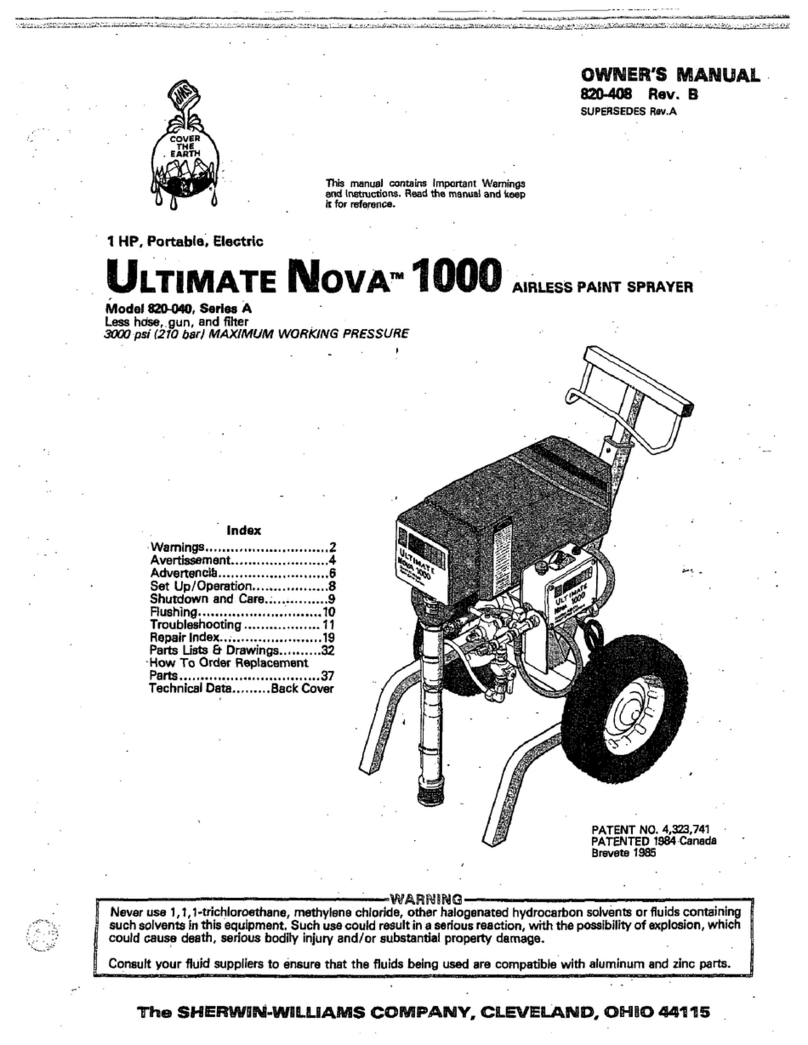
Sherwin-Williams
Sherwin-Williams ULTIMATE NOVA 1000 User manual
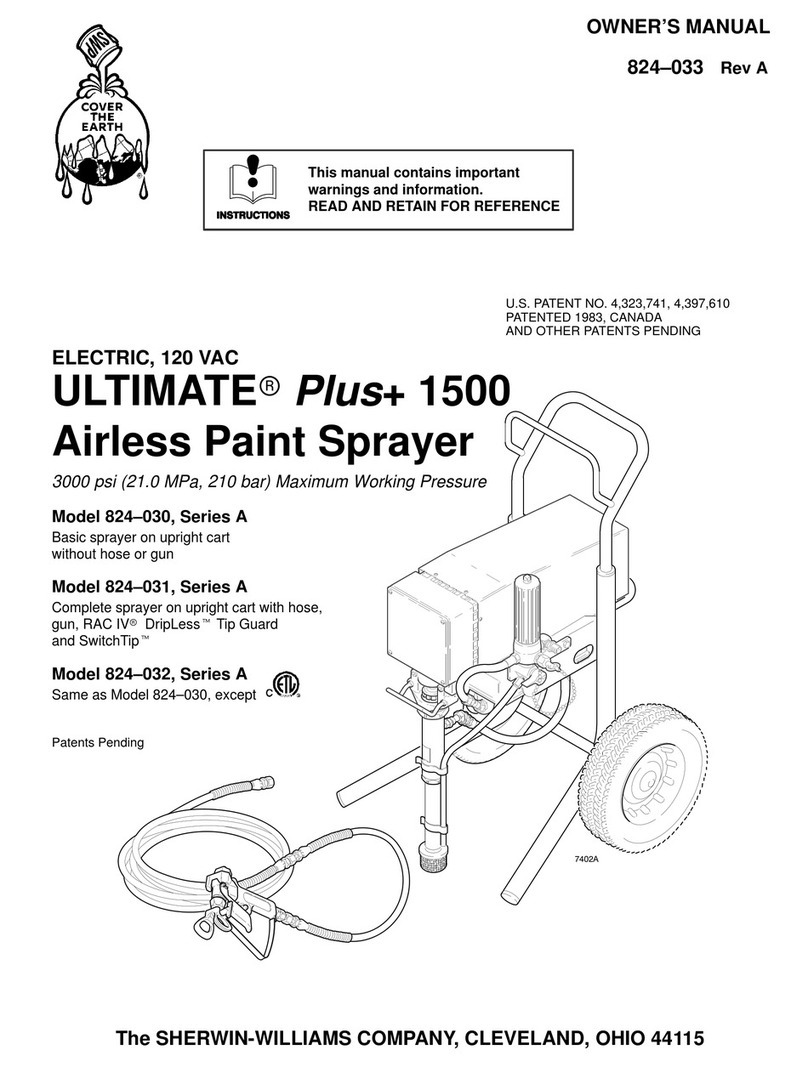
Sherwin-Williams
Sherwin-Williams ULTIMATE 824-030 User manual
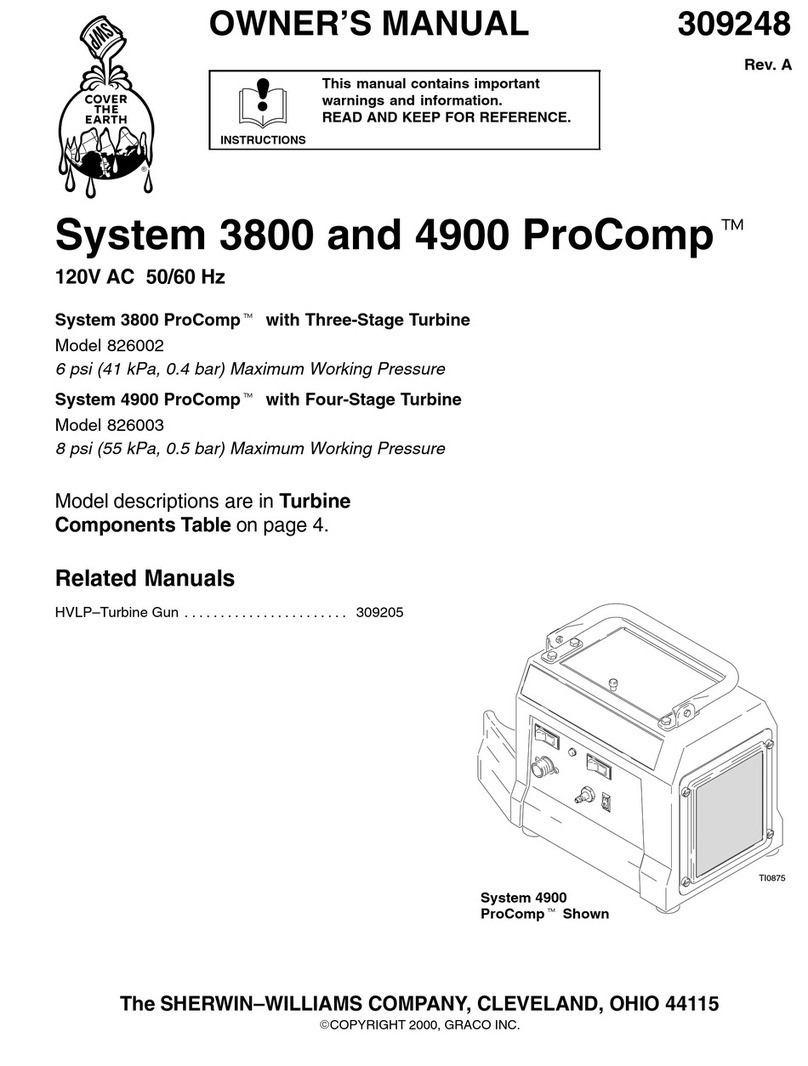
Sherwin-Williams
Sherwin-Williams ProComp 3800 User manual

Sherwin-Williams
Sherwin-Williams 820-206 User manual
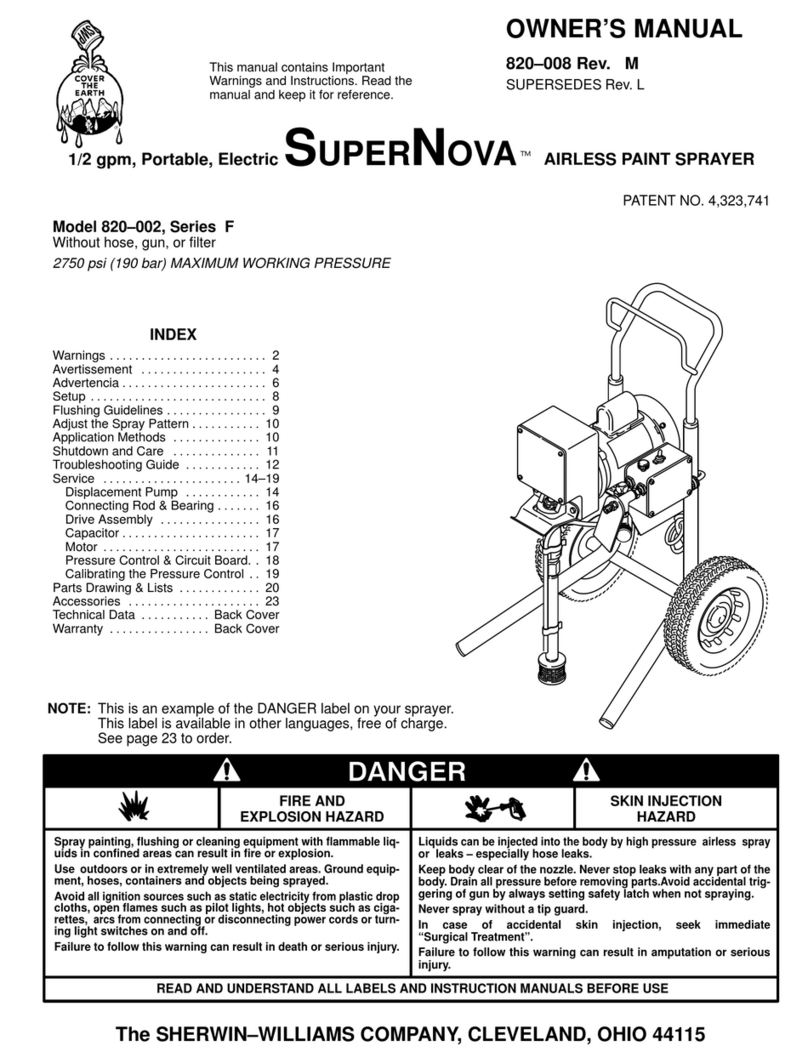
Sherwin-Williams
Sherwin-Williams SUPERNOVA 820-002 User manual
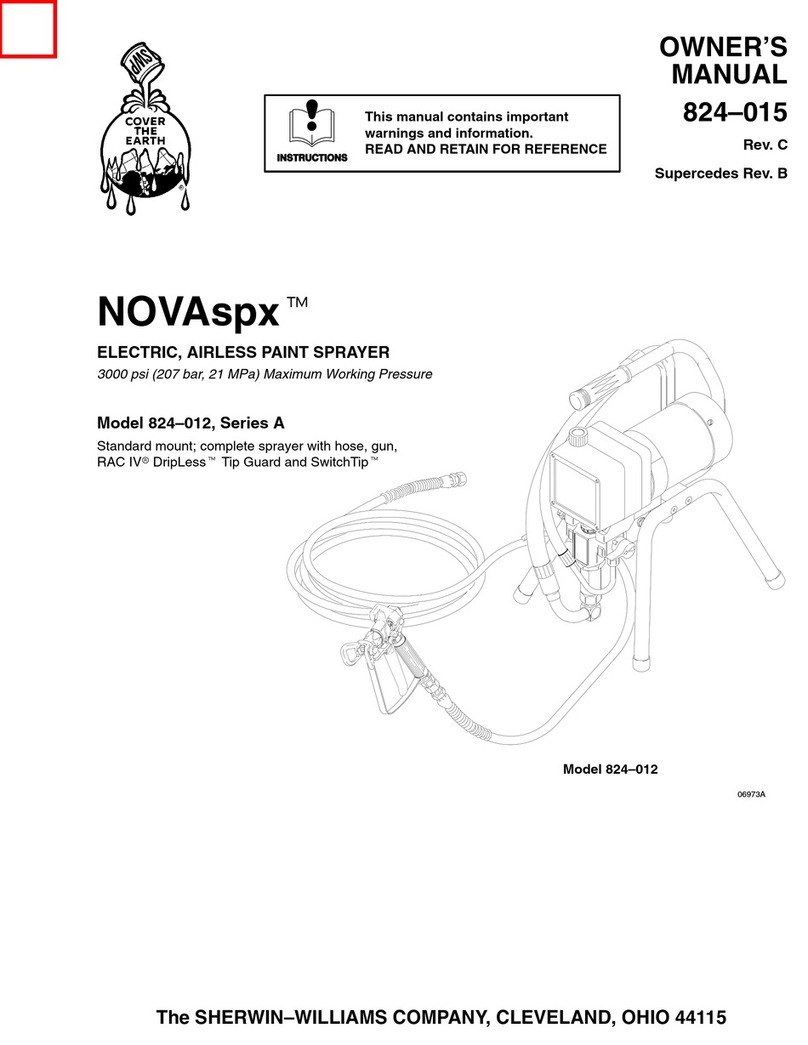
Sherwin-Williams
Sherwin-Williams NOVAspx 824-012 User manual
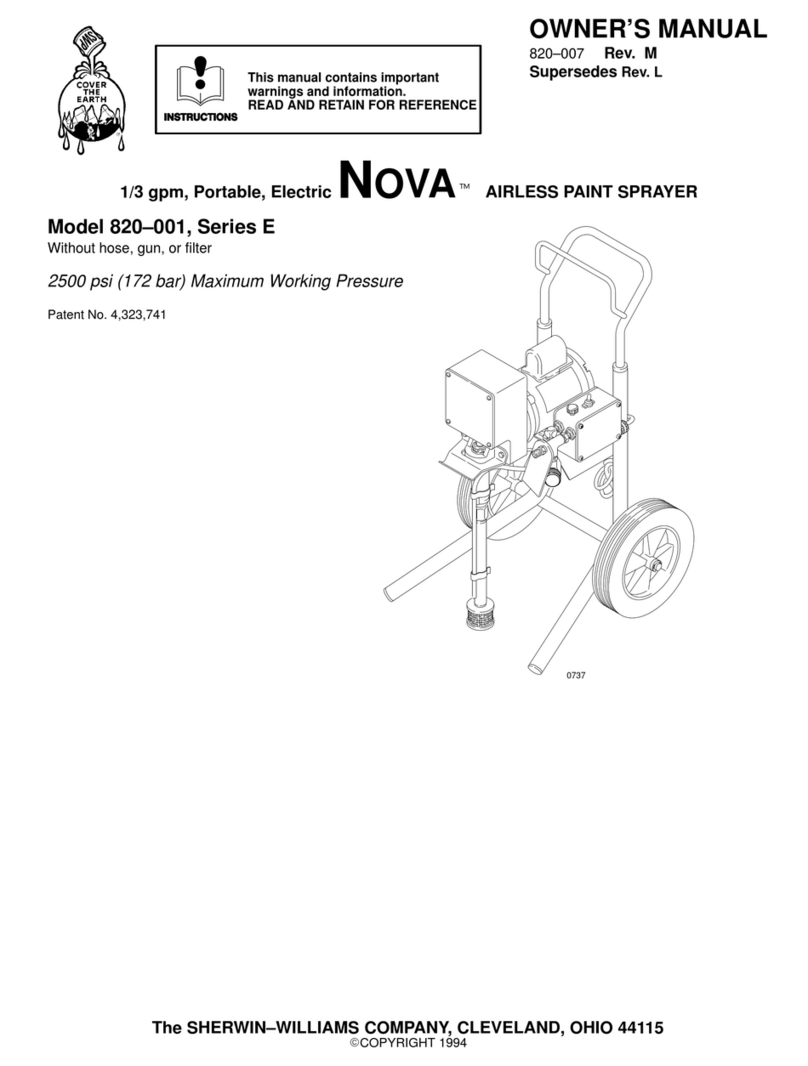
Sherwin-Williams
Sherwin-Williams 820-001 User manual

Sherwin-Williams
Sherwin-Williams ULTIMATE Plus+ 1000 User manual

Sherwin-Williams
Sherwin-Williams 820169 D Series User manual
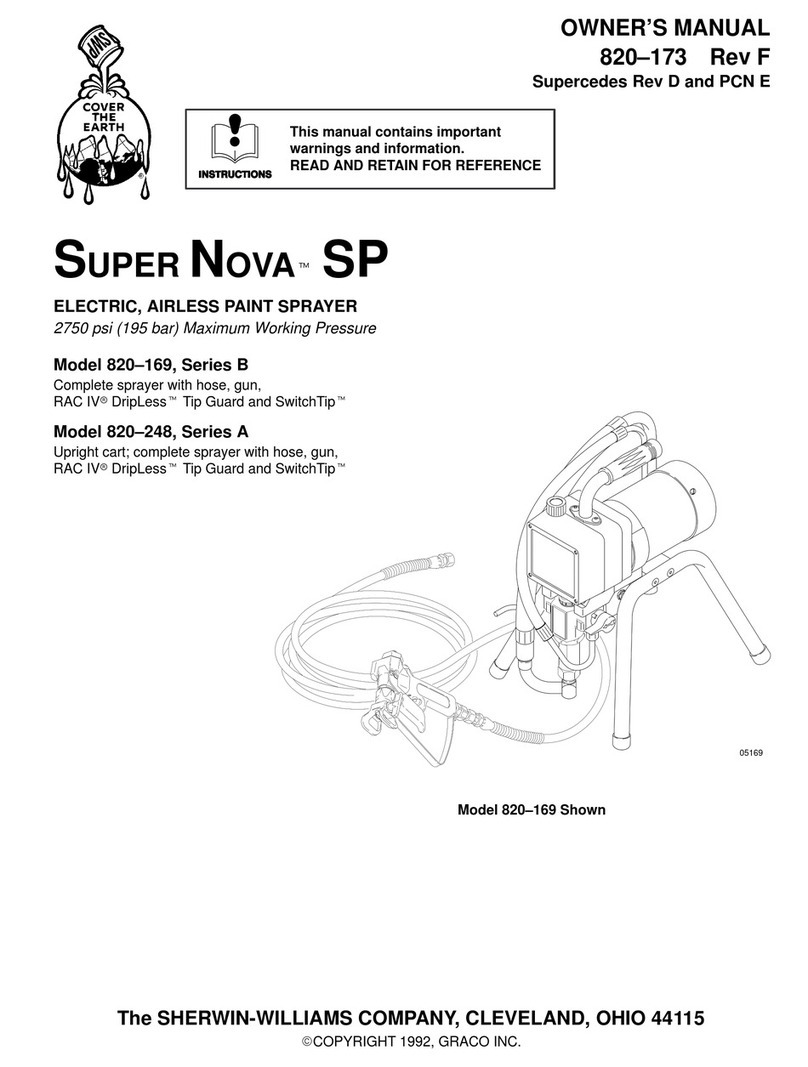
Sherwin-Williams
Sherwin-Williams 820-169 Series B User manual
